Brisbane, the capital city of Queensland, Australia, is home to a diverse range of birdlife. With its subtropical climate, sprawling greenspaces, and proximity to the coast and hinterland, the city provides a variety of habitats for native and migrating bird species.
From colorful parrots and cockatoos to elegant waterbirds, predatory raptors to tiny finches, the avian fauna of Brisbane captivates both birdwatchers and casual observers.
This article provides a snapshot of some of the most iconic and fascinating birds of Brisbane, highlighting their distinctive features, behavioral patterns, and conservation status.
1. Brahminy Kite
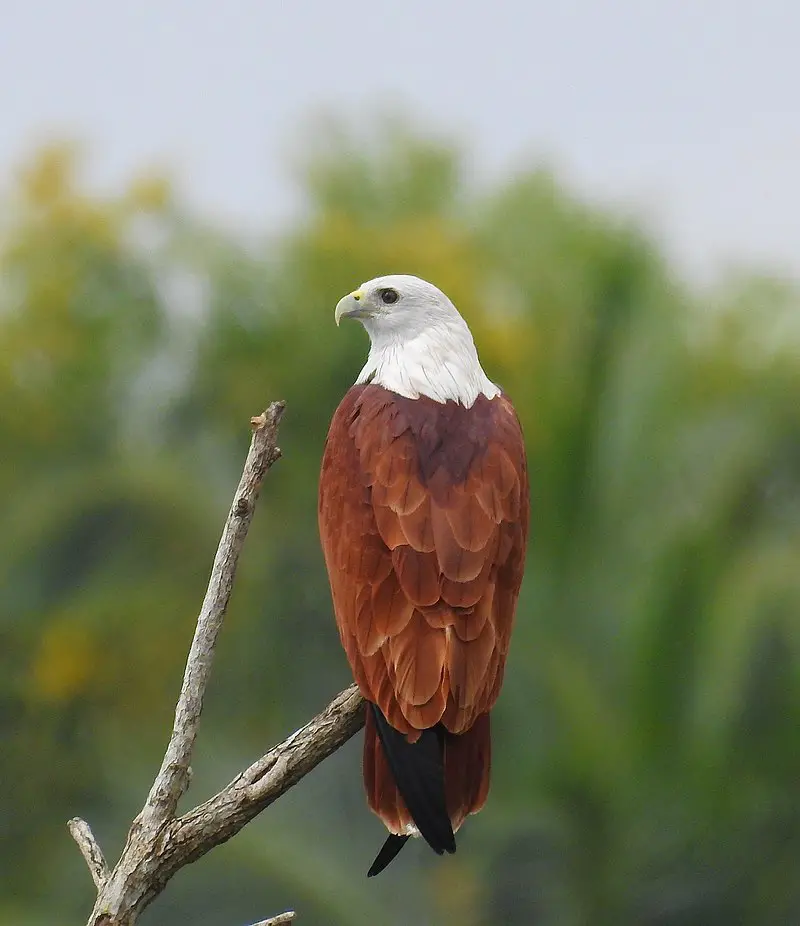
The Brahminy Kite is a majestic bird of prey native to the Indian subcontinent, Southeast Asia and Australia. It was formerly known as the red-backed sea eagle in Australia.
This medium-sized raptor has a distinctive white head with rufous brown feathers covering its body, making it easily recognisable from far away. The wingspan can reach up to 5 feet wide.
Brahminy kites are found mainly on coasts and inland wetlands where they feed mostly on dead fish or carrion left by other animals.
They also hunt for small mammals such as rodents or reptiles like lizards and snakes during dry spells when food sources become scarce.
These birds have adapted well over time and will even scavenge for food near picnic sites or urban areas if need be.
Overall these beautiful creatures are an important part of their local ecosystems which rely heavily upon them for keeping animal populations balanced through natural predation methods instead of manmade ones; this ensures that nature remains healthy so future generations may enjoy it too.
Scientific classification:
| Kingdom | Animalia |
| Phylum | Chordata |
| Class | Aves |
| Order | Accipitriformes |
| Family | Accipitridae |
| Genus | Haliastur |
| Species | H. indus |
Also Featured In: Most Common Types of Bangladeshi Birds, Birds of Goa
2. Australian Magpie
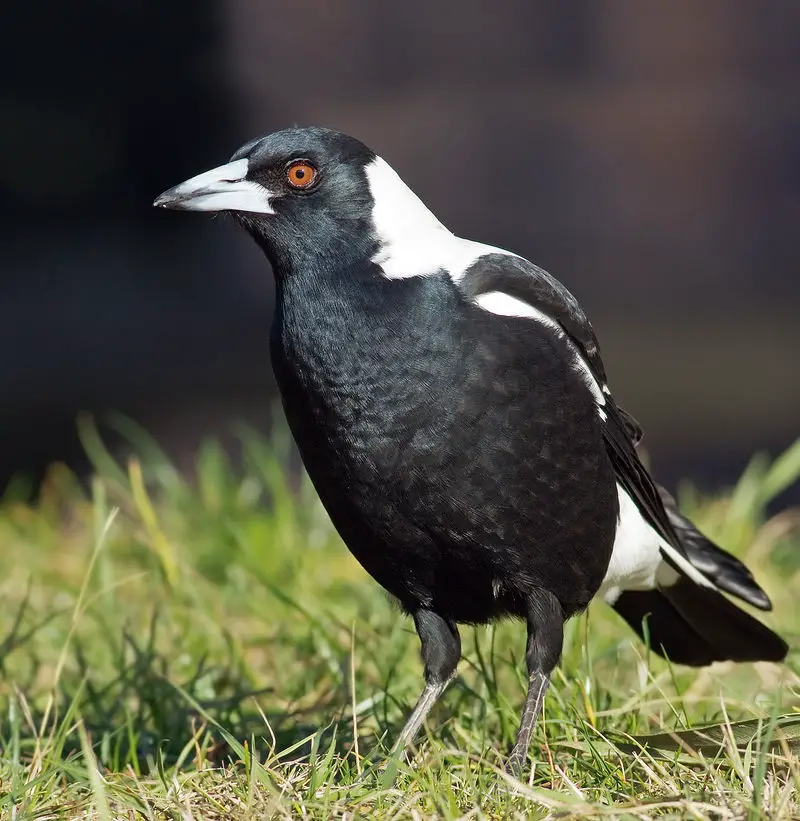
The Australian magpie is a beautiful passerine bird native to Australia and southern New Guinea.
It has distinctive black and white plumage, with males having more brightly coloured feathers than females.
The species is part of the Artamidae family, so it’s closely related to the Black Butcherbird (Melloria quoyi). Nine different subspecies have been recognised which vary slightly in size and colouring.
Magpies are omnivorous birds meaning they eat both plants and animals; their diet consists mainly of insects, small reptiles and amphibians as well as some grains such as wheat or oats.
They also enjoy drinking from pools of water on hot days. In general these birds display high intelligence when compared to other avian species – able to mimic human speech patterns quite accurately even in captivity.
Overall this majestic creature deserves our appreciation for its beauty, loyalty and fascinating behaviour.
Scientific classification:
| Kingdom | Animalia |
| Phylum | Chordata |
| Class | Aves |
| Order | Passeriformes |
| Family | Artamidae |
| Genus | Gymnorhina Gray, GR, 1840 |
| Species | G. tibicen |
Also Featured In: Most common birds in Australia, Black And White Birds You Don’t Know About
3. Laughing Kookaburra
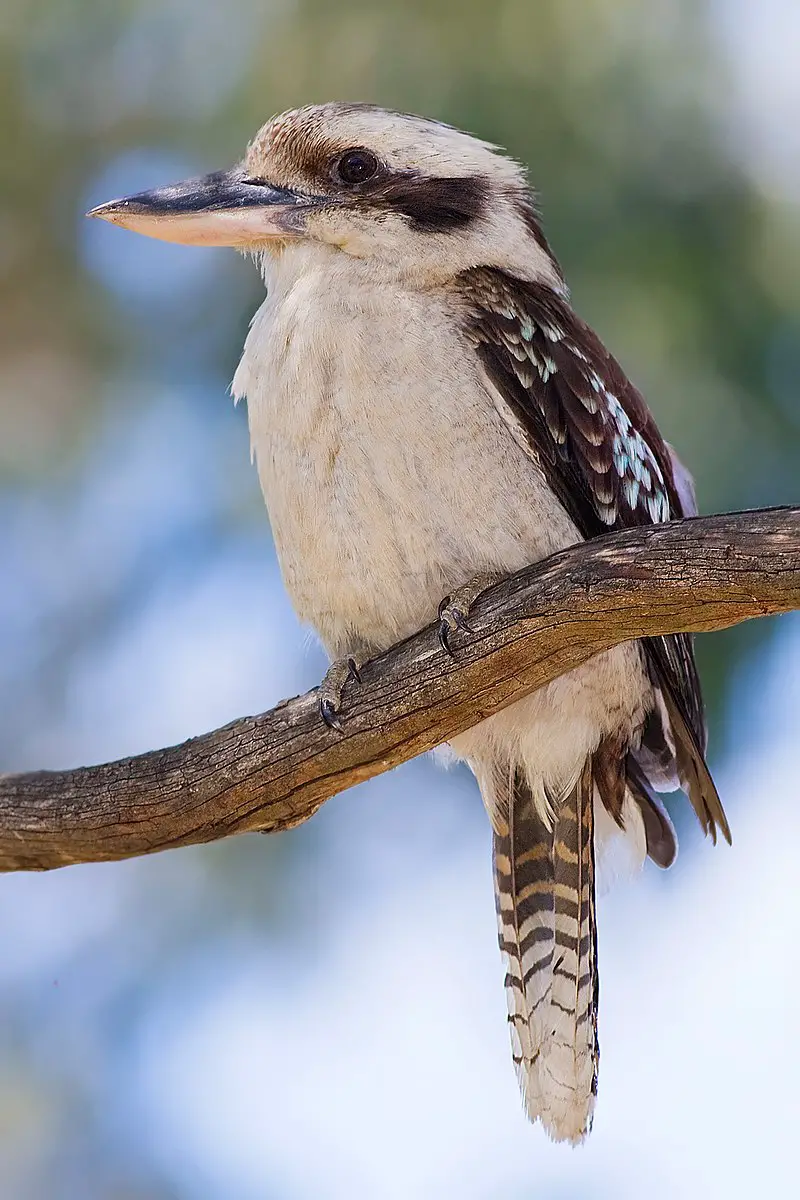
The Laughing Kookaburra is a beautiful bird with distinct features. It has a whitish head and brown eye-stripe, along with an upper body that is predominantly dark brown.
On its wings are mottled light blue patches which make it stand out even more. Its underparts are cream white while its tail is barred in rufous and black colours.
Male and female birds have the same plumage, making them easy to identify as belonging to this species of kingfisher subfamily Halcyoninae.
They can be found living around woodlands or open forests throughout eastern Australia, where they feed on small reptiles, insects or amphibians by swooping down from a perch above them before carrying their prey back up again for consumption.
The sound of their loud distinctive call – “koo-kaa-brrr” – brings joy to many Australians who appreciate these wonderful creatures inhabiting our land
Scientific classification:
| Kingdom | Animalia |
| Phylum | Chordata |
| Class | Aves |
| Order | Coraciiformes |
| Family | Alcedinidae |
| Subfamily | Halcyoninae |
| Genus | Dacelo |
| Species | D. novaeguineae |
Also Featured In: Birds You’ll Find in Zoo, Birds Typically Found in Australian Rainforest
4. Rainbow Lorikeet
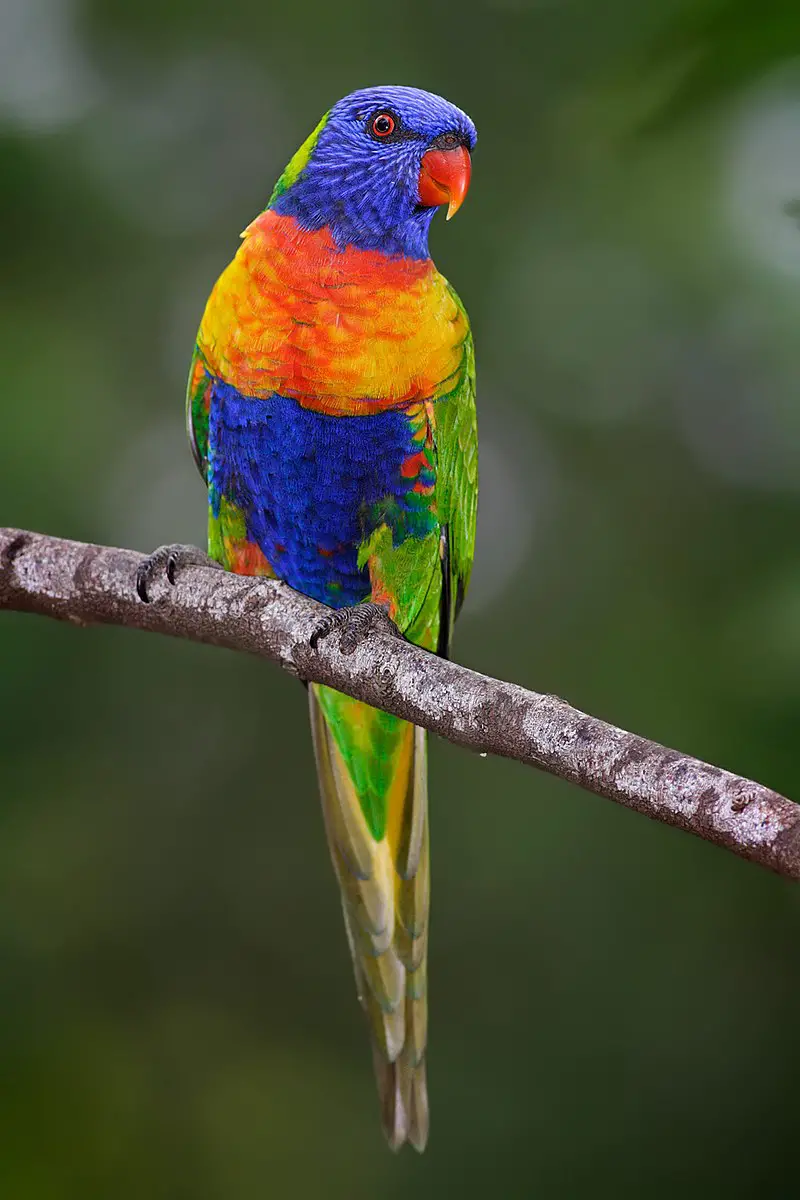
The Rainbow Lorikeet is a brightly coloured parrot native to Australia. It inhabits rainforests, coastal bushlands and woodland areas along the eastern seaboard from northern Queensland to South Australia.
These birds have an unmistakable bright rainbow plumage of blue, red and yellow feathers which make them easy to recognise in their natural environment.
They are also known for their distinctive call – often described as sounding like ‘kikiki-kyu’.
Six related species were once considered subspecies of the Rainbow Lorikeet but these days they are recognised separately due to differences in size, colouration and behaviour.
Despite being introduced elsewhere such as New Zealand, Hawaii or California they remain largely confined within their original range in Australia – where they can be seen soaring through the air or drinking nectar from flowers with its long tongue.
Scientific classification:
| Kingdom | Animalia |
| Phylum | Chordata |
| Class | Aves |
| Order | Psittaciformes |
| Family | Psittaculidae |
| Genus | Trichoglossus |
| Species | T. moluccanus |
Also Featured In: Aviary Birds You Should Know, Birds that Live Near Adelaide
5. Galah
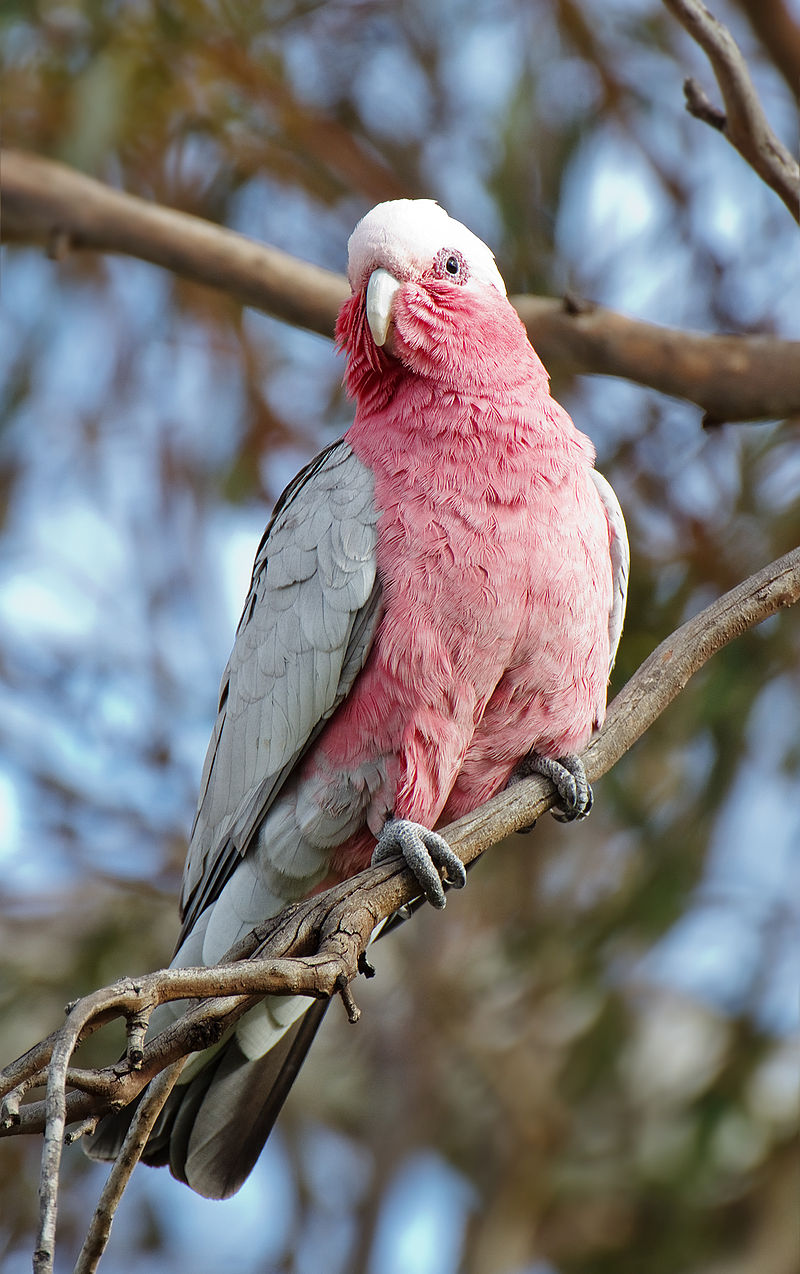
The Galah is a striking bird, easily identified by its distinctive pink and grey plumage. It belongs to the cockatoo family and is found throughout Australia.
With its loud call, it’s not hard to spot this vibrant bird in both rural and urban settings. They are also known as rose-breasted cockatoos due to their bright feathers on their chest.
These birds form strong relationships with each other, living together in pairs or small groups while they look for food among grasslands or open woodlands.
Their diet consists of seeds, fruits, buds & flowers making them valuable contributors to ecosystems across the country.
Scientific classification:
| Kingdom | Animalia |
| Phylum | Chordata |
| Class | Aves |
| Order | Psittaciformes |
| Family | Cacatuidae |
| Genus | Eolophus Bonaparte, 1854 |
| Species | E. roseicapilla |
6. Rainbow Bee-Eater
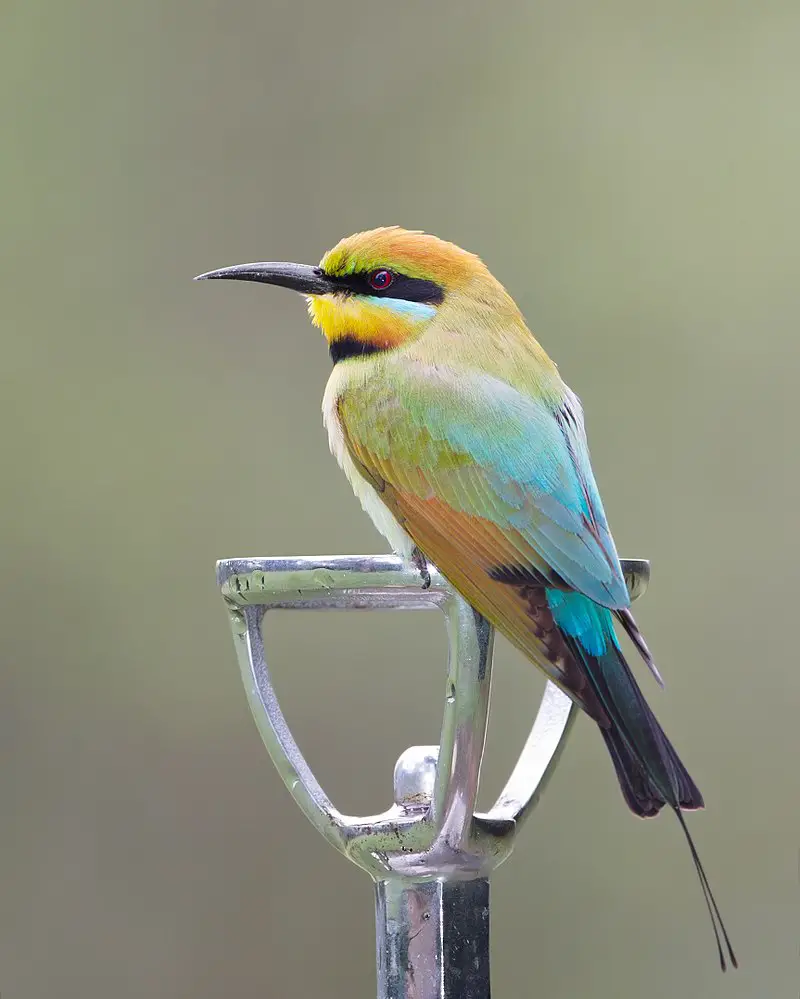
The Rainbow bee-eater (Merops ornatus) is a delightful near passerine bird belonging to the bee-eater family Meropidae.
It is found exclusively in Australia, making it one of only two species of its kind throughout the world; its closest relative being located in Southern and Eastern Africa – the olive bee-eater (Merops superciliosus).
Its stunning plumage features a unique palette of colours including shades pinkish reds, blues, greens and yellows which make for an impressive display when seen up close.
Due to their diet consisting mainly on bees and other insects they have adapted specialised beaks with serrated edges that allow them to easily capture their prey mid flight.
A truly remarkable sight indeed.
Scientific classification:
| Kingdom | Animalia |
| Phylum | Chordata |
| Class | Aves |
| Order | Coraciiformes |
| Family | Meropidae |
| Genus | Merops |
| Species | M. ornatus |
Also Featured In: Common Birds of Lombok,
7. Crested Pigeon
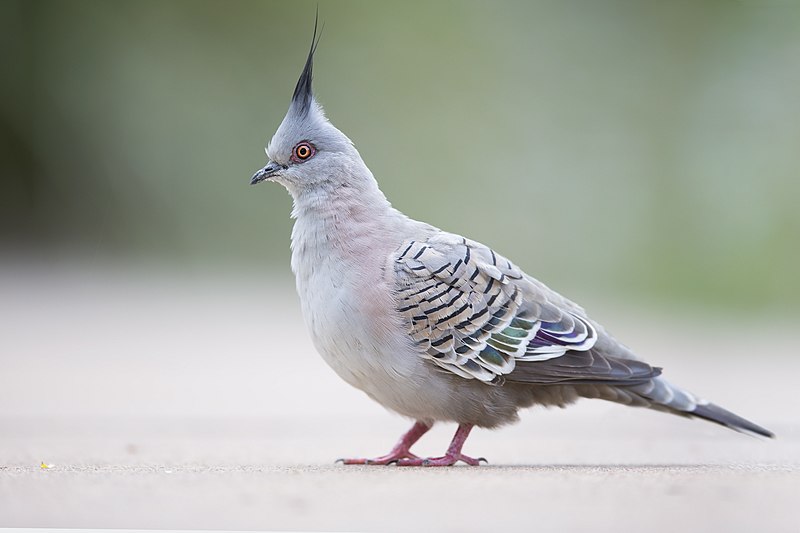
The Crested Pigeon is a medium-sized bird found widely across mainland Australia. It stands out from other pigeons due to its unique erect crest on the top of its head, which gives it an unmistakable look.
The body of this pigeon is slate grey in color with lighter gray undersides and chestnut colored wings that have white tips when they are open while flying.
Its striking black tipped yellow beak and pale blue eye ring add further interest to this beautiful species.
When alarmed, these birds will make loud clapping sounds by bringing their wings together above their backs as part of their defensive behavior.
Scientific classification:
| Kingdom | Animalia |
| Phylum | Chordata |
| Class | Aves |
| Order | Columbiformes |
| Family | Columbidae |
| Genus | Ocyphaps G.R. Gray, 1842 |
| Species | O. lophotes |
Also Featured In: Most Common Birds in Oceania,
8. Australian Pelican
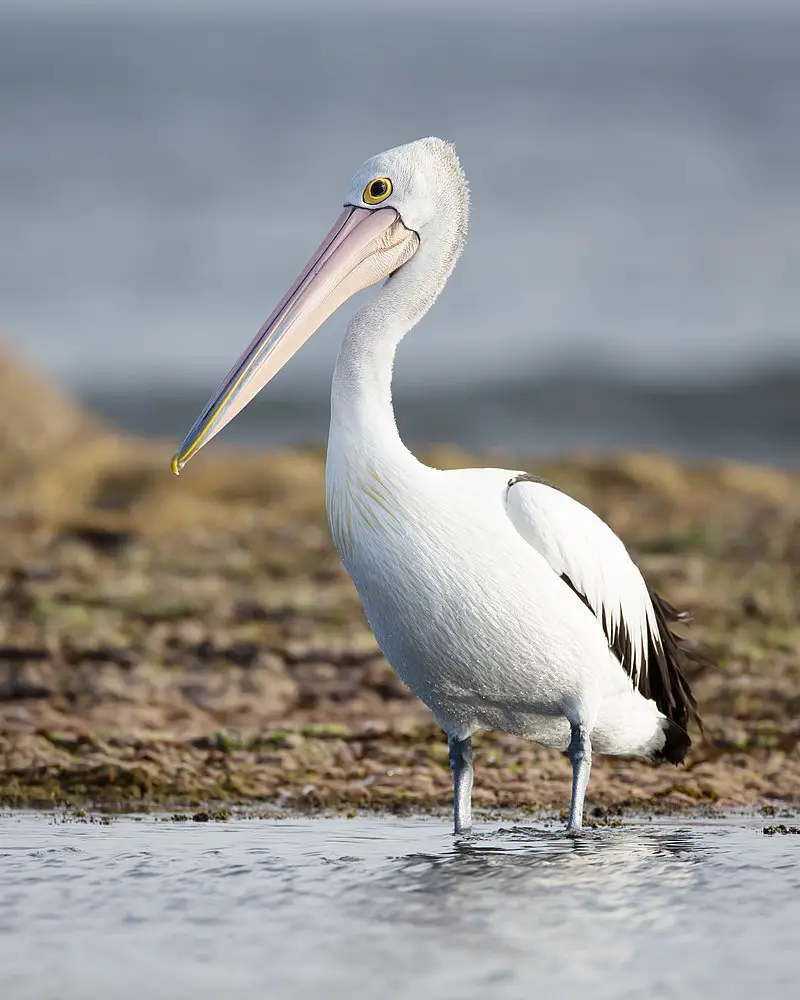
The Australian pelican is a majestic large waterbird with predominantly white plumage and black wings.
It has the longest bill of any living bird, which it uses to fish for its main source of food in both inland and coastal waters of Australia, New Guinea, Fiji, parts of Indonesia and as a vagrant in New Zealand.
They usually feed together by forming lines or circles around their prey before dipping down into the water at once.
In addition to fishing they also scavenge on other sources such as eggs from nesting seabirds or carrion.
Their unique appearance makes them an iconic species that can be easily recognised across many areas throughout Australasia making them popular amongst tourists who come to see them up close.
Scientific classification:
| Kingdom | Animalia |
| Phylum | Chordata |
| Class | Aves |
| Order | Pelecaniformes |
| Family | Pelecanidae |
| Genus | Pelecanus |
| Species | P. conspicillatus |
Also Featured In: Birds of New Caledonia,
9. Noisy Miner
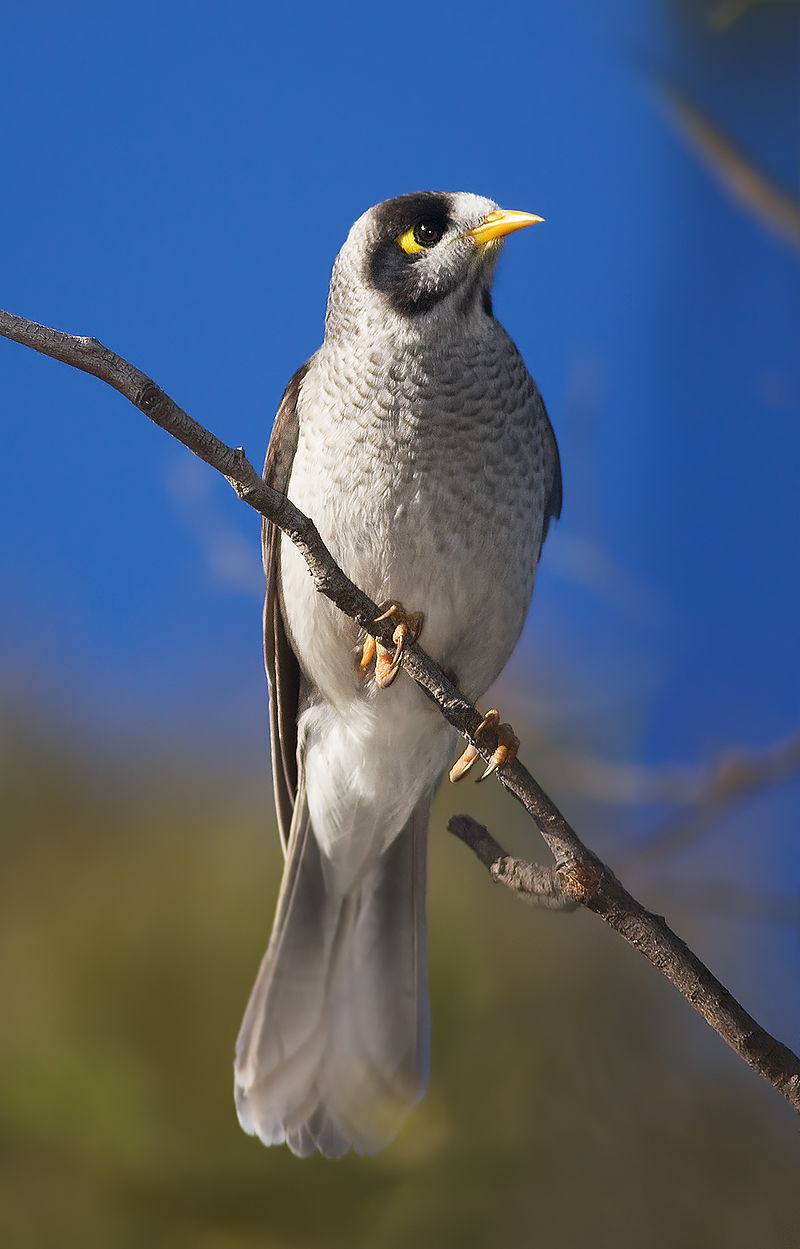
The Noisy Miner is a beautiful bird native to eastern and southeastern Australia. It has a grey body, black head, orange-yellow beak and feet, with an eye patch that ranges from yellow to more intense in Tasmanian birds.
The tail feathers are distinguished by white tips which provide it with its signature look. These miners have the ability to produce loud calls when communicating or defending their territory – hence their name.
They mainly feed on fruit but also insects, nectar and small lizards found around gardens.
As they are quite common in urban areas of Australia, these birds make for some delightful avian visitors.
Scientific classification:
| Kingdom | Animalia |
| Phylum | Chordata |
| Class | Aves |
| Order | Passeriformes |
| Family | Meliphagidae |
| Genus | Manorina |
| Species | M. melanocephala |
10. Bush Stone-Curlew
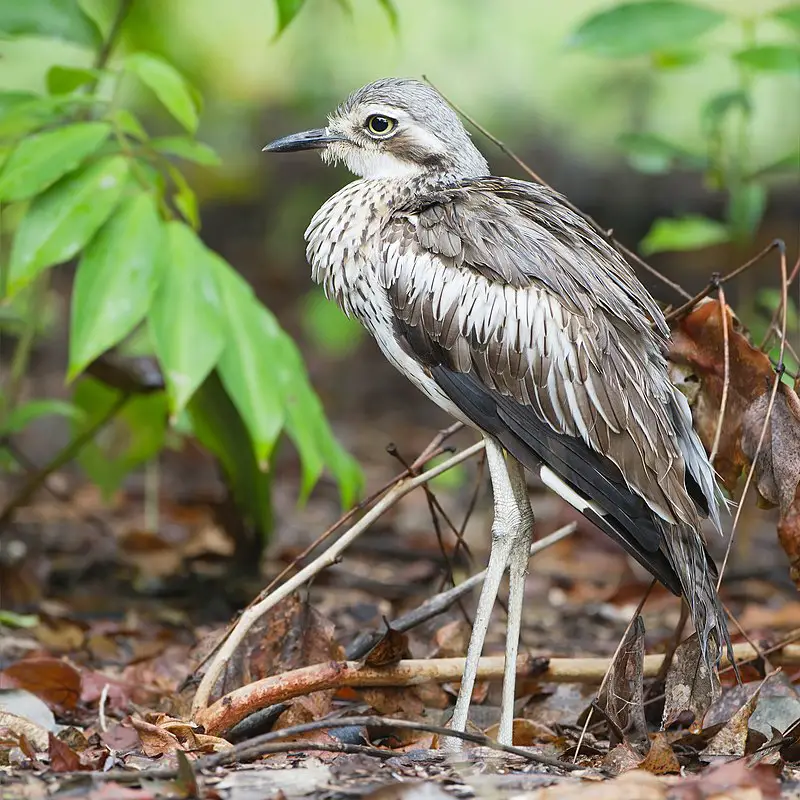
The Bush Stone-Curlew, also known as the Iben Bird, is an endemic species of Australia found in open plains and woodlands. It has grey-brown coloration with dark streaks and large eyes, making it easy to identify.
During night time this bird looks for invertebrates such as insects by slowly stalking its prey. Its long legs allow it to easily traverse across vast landscapes while hunting for food.
The Bush Stone-Curlew plays a vital role in maintaining balance within the ecosystem through controlling insect population growth which can be damaging if not monitored carefully.
Unfortunately due to human interference this species has become endangered so all efforts should be made towards conserving them before they are lost forever from our planet’s biodiversity.
Scientific classification:
| Kingdom | Animalia |
| Phylum | Chordata |
| Class | Aves |
| Order | Charadriiformes |
| Family | Burhinidae |
| Genus | Burhinus |
| Species | B. grallarius |
11. Masked Lapwing
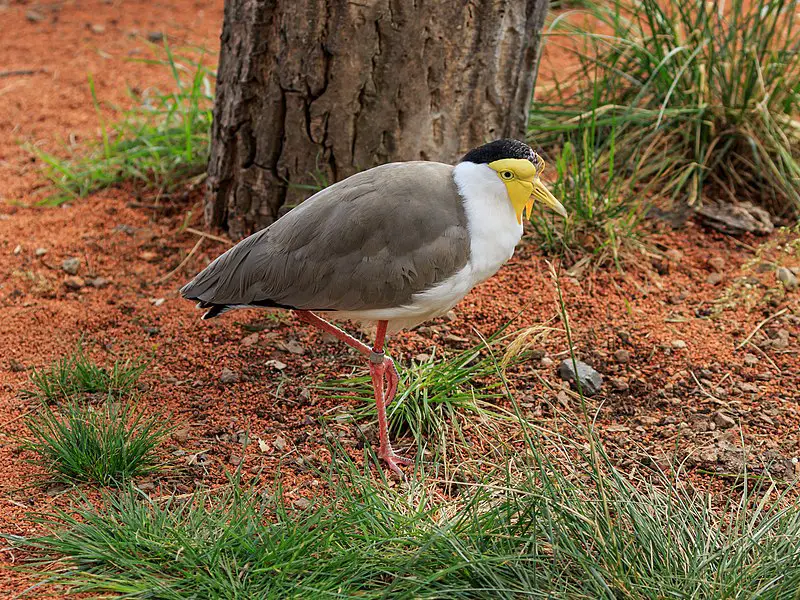
The Masked Lapwing is a large, distinctive bird that can be found in Australia, New Zealand and parts of Papua New Guinea.
It spends most of its time on the ground searching for food such as insects and worms, making it an important part of the local ecology.
It has several loud calls that are easily recognisable – from its ‘kwee-ep’ alarm call to its territorial ‘chi-wick’ call.
The Masked Lapwing is particularly known for swooping down when disturbed or threatened; however this behaviour serves to protect their nests with chicks during breeding season.
They inhabit open fields and grasslands which makes them easy to see if you’re lucky enough.
Scientific classification:
| Kingdom | Animalia |
| Phylum | Chordata |
| Class | Aves |
| Order | Charadriiformes |
| Family | Charadriidae |
| Genus | Vanellus |
| Species | V. miles |
12. Noisy Friarbird
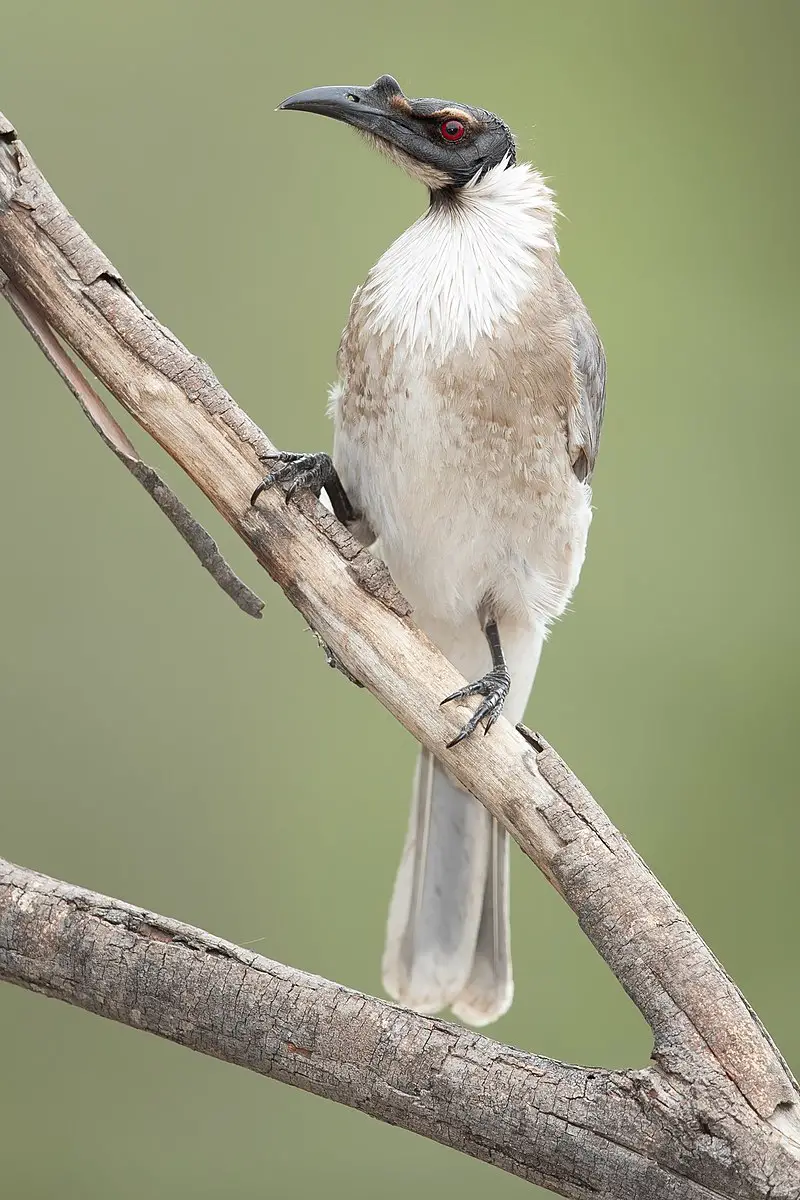
The Noisy Friarbird is a native of Southern New Guinea and Eastern Australia. It’s easily recognisable due to its brown-grey colouration, as well as the prominent knob on its head which is bare black skinned.
This bird belongs to the honeyeater family Meliphagidae, making it one of several species referred to as friarbirds with their featherless heads.
The diet for this particular species consists mainly of insects such as bees and ants, but also nectar from flowers when in season.
First described by ornithologist John Latham in 1802, they are commonly found near woodlands close to water sources like rivers or streams where there is plenty of food available during breeding season which usually occurs between August and December each year.
Scientific classification:
| Kingdom | Animalia |
| Phylum | Chordata |
| Class | Aves |
| Order | Passeriformes |
| Family | Meliphagidae |
| Genus | Philemon |
| Species | P. corniculatus |
Also Featured In: Papua New Guinea birds,
13. Silvereye
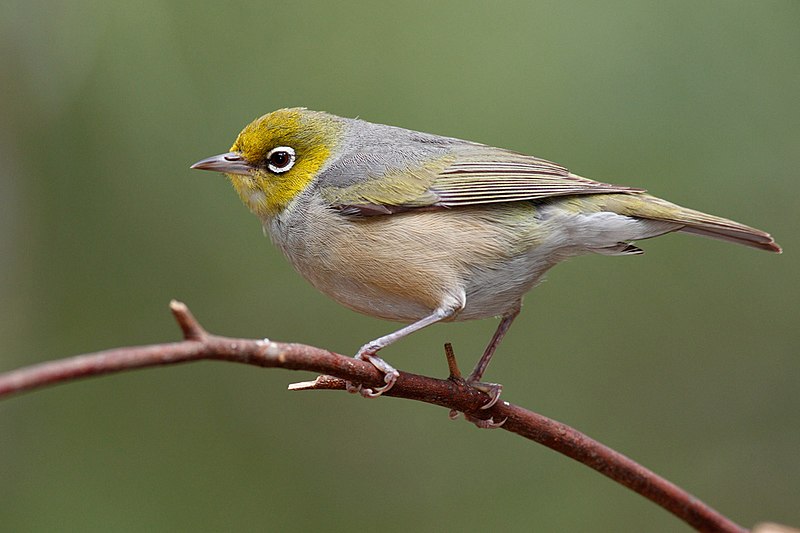
The silvereye, also known as wax-eye, is a tiny passerine bird native to the south-west Pacific region. It was first recorded in New Zealand in 1832 and there were greater numbers by 1856.
These birds are omnivorous feeders that make their home in open woodlands or gardens with lush vegetation.
Their plumage has greyish tones on top of its head and wings giving it a silver sheen look which inspired its common name ‘silvereye’.
The underside of these birds have white feathers allowing for camouflage among foliage when they fly low over shrubs and trees seeking food such as nectar, insects and fruit.
They are social creatures who often flock together to share meals while communicating through their unique chirps.
Scientific classification:
| Kingdom | Animalia |
| Phylum | Chordata |
| Class | Aves |
| Order | Passeriformes |
| Family | Zosteropidae |
| Genus | Zosterops |
| Species | Z. lateralis |
Also Featured In: New Zealand Birds, Birds of King Island
14. Buff-Banded Rail
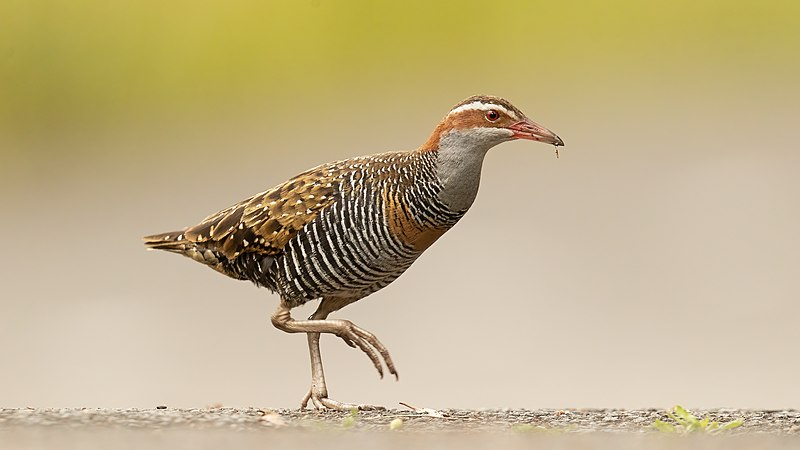
The Buff-banded Rail is a beautiful bird found across Australasia and the South West Pacific. It has distinctive black, brown, white and buff plumage which makes it easily recognizable.
Its long legs are adapted for wading in shallow water where it feeds on small fish, crustaceans, insects and vegetable matter.
This species is highly dispersive with some subspecies being found as far away as the Philippines (where they are known as Tikling) or New Zealand (known there as Moho-p).
With its adaptability to various habitats such as mangroves swamps, saltmarshes and farmlands; this species can be seen running around during low tide looking for food or hiding among vegetation when alarmed by potential danger.
Scientific classification:
| Kingdom | Animalia |
| Phylum | Chordata |
| Class | Aves |
| Order | Gruiformes |
| Family | Rallidae |
| Genus | Hypotaenidia |
| Species | H. philippensis |
Also Featured In: Timor-Leste birds,
15. Dusky Moorhen
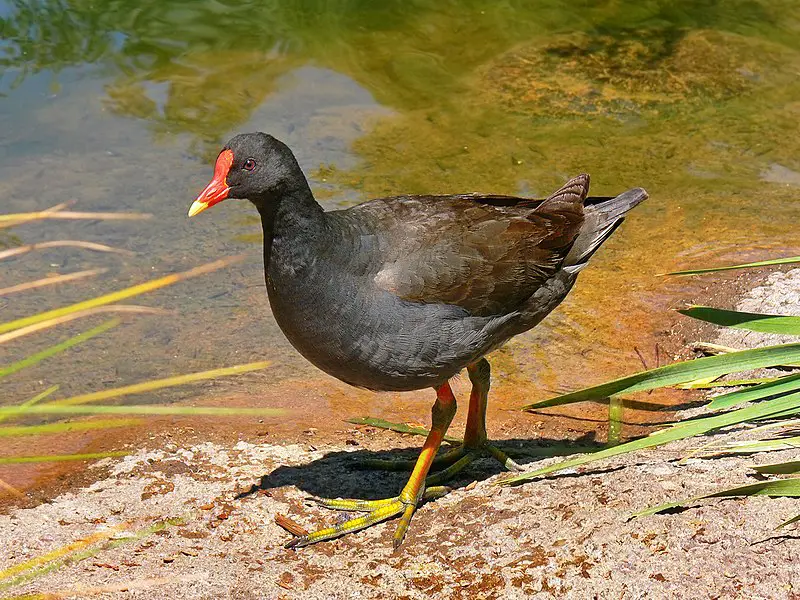
The dusky moorhen is a species of bird found in India, Australia, New Guinea, Borneo and Indonesia. It has dark plumage with an iridescent green sheen on its back and wings.
Its beak and legs are yellow-orange in color. The tail is long and pointed. Dusky moorhens live around freshwater wetlands such as swamps or ponds where they feed largely on aquatic vegetation but may also eat small insects or fish if available.
They often live alongside other birds from the same genus like purple swamphens or Eurasian coots which have similar appearances but different habitats preferences than their own species’.
Although timid when approached by humans these birds still make fascinating subjects for observation due to their unique behaviors within family groups that can help us understand more about them.
Scientific classification:
| Kingdom | Animalia |
| Phylum | Chordata |
| Class | Aves |
| Order | Gruiformes |
| Family | Rallidae |
| Genus | Gallinula |
| Species | G. tenebrosa |
16. Nankeen Kestrel
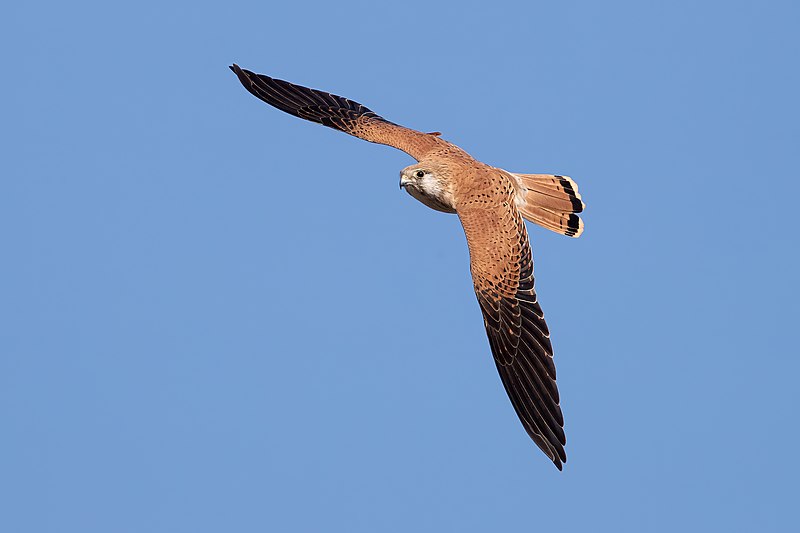
The nankeen kestrel is a small bird of prey native to Australia and New Guinea. Unlike many raptors, it does not rely on speed to capture its prey; instead, it perches in an exposed spot or hovers over fields and grasslands.
It belongs to the genus Falco which also includes other species such as peregrine falcons.
This bird typically has cinnamon-brown upperparts with dark wings and tail whilst its underside is usually pale buffish-white colouring with narrow black barring across the chest area.
Its diet consists mainly of insects but can include reptiles, amphibians, mice and even some birds among others depending on their availability within their habitat range.
The Nankeen Kestrel is an important part of our ecosystems providing essential services such as pest control for farmers by preying upon pests like locusts while also being a keystone species that influences surrounding habitats through predation or competition for resources amongst other animals.
Scientific classification:
| Kingdom | Animalia |
| Phylum | Chordata |
| Class | Aves |
| Order | Falconiformes |
| Family | Falconidae |
| Genus | Falco |
| Species | F. cenchroides |
17. White-Faced Heron
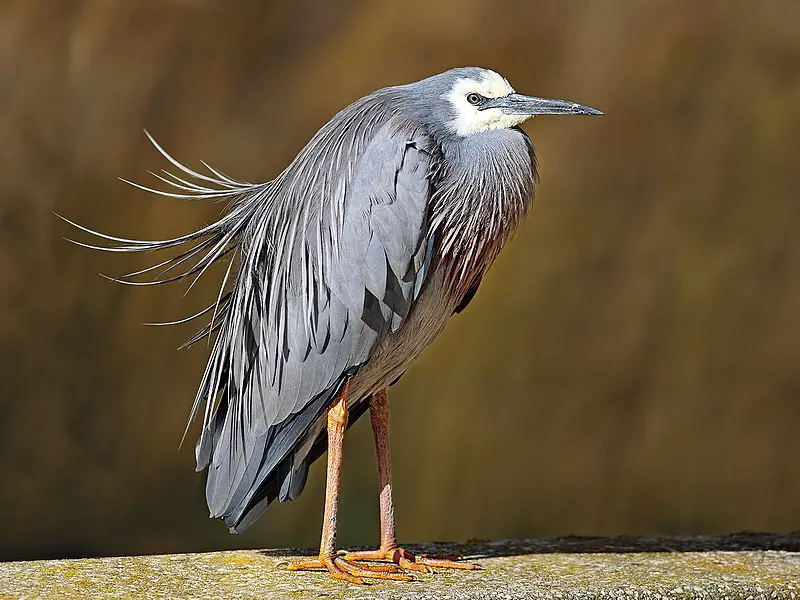
The White-faced Heron is a common sight throughout much of Australasia. With its pale, bluish grey feathers and yellow legs this bird stands out in the crowd.
It can be found on New Guinea, Torres Strait Islands and Indonesia as well as Australia and New Zealand but tends to avoid dry areas. This medium sized heron has one distinct feature – a white face.
Its diet consists mainly of small fish, lizards, frogs insects and crustaceans which it hunts for by wading into shallow water or searching through grasses near wetlands.
In flight they appear graceful with their long neck tucked back against their body giving them an elegant silhouette against the sky.
Their behaviour shows intelligence when finding food sources or evading predators making them interesting creatures to observe in nature.
Scientific classification:
| Kingdom | Animalia |
| Phylum | Chordata |
| Class | Aves |
| Order | Pelecaniformes |
| Family | Ardeidae |
| Genus | Egretta |
| Species | E. novaehollandiae |
Also Featured In: Christmas Island Birds, Birds of Tasmania
18. Brown Falcon
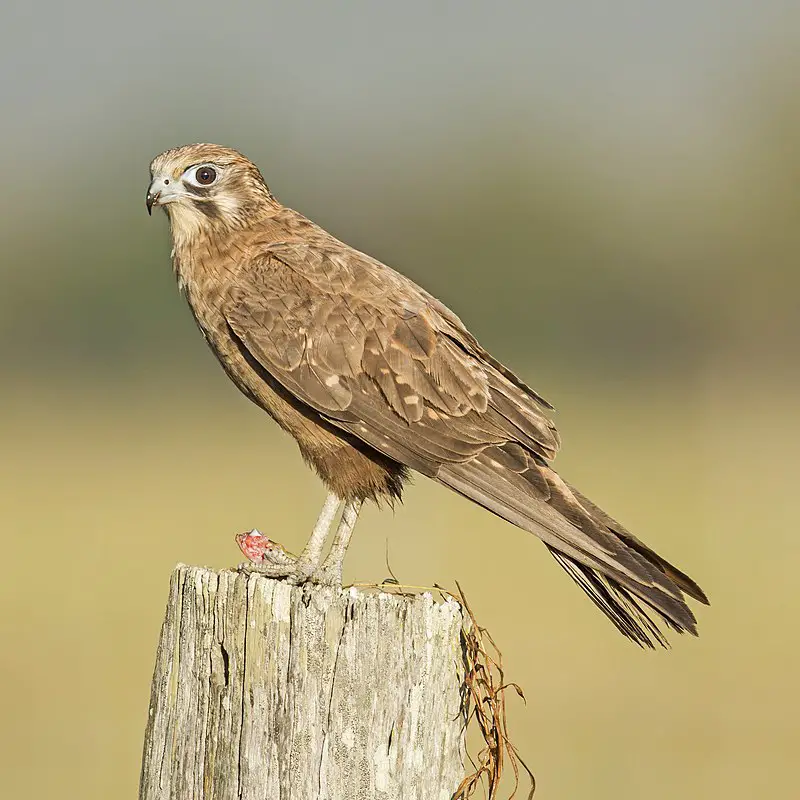
The Brown Falcon is a majestic bird native to Australia and New Guinea. It has a multitude of plumage morphs, with the primary difference being between pale and dark morph birds.
The light-colored ones typically have white undersides with some streaking, while their darker counterparts usually feature entirely brown upper parts.
These large falcons are highly adaptable predators that hunt small animals for food such as rabbits, snakes or lizards.
They also feed on carrion and grains during wintertime when prey becomes scarce. Thanks to its impressive flying abilities, it can quickly soar over vast distances in search of sustenance or mates by relying on powerful thermals ascending from the ground below them.
Scientific classification:
| Kingdom | Animalia |
| Phylum | Chordata |
| Class | Aves |
| Order | Falconiformes |
| Family | Falconidae |
| Genus | Falco |
| Species | F. berigora |
Also Featured In: Falcons Species, Common Flinders Island Birds
19. Australian Hobby
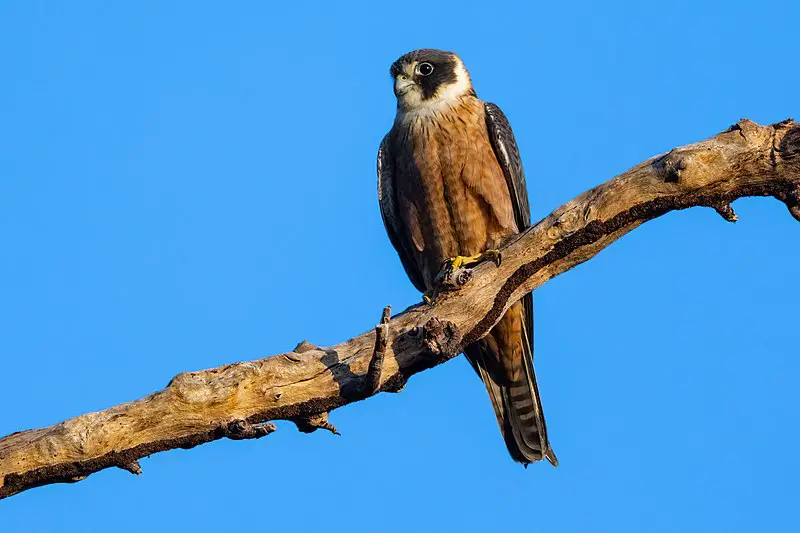
The Australian hobby is a small bird of prey found across Australia and its neighbouring countries. It has long primary wing feathers, which give it the scientific name Falco longipennis – meaning ‘long-winged’.
During migration season, members of this species can be seen on islands in Indonesia and New Guinea. The Australian hobby is mostly active during daylight hours but will sometimes hunt at night too.
Its diet consists mainly of insects such as dragonflies and grasshoppers, although some larger birds are also taken.
This adaptable predator inhabits both open areas like woodland clearings as well as densely populated urban environments where they take advantage of abundant food sources like city parks or gardens.
Scientific classification:
| Kingdom | Animalia |
| Phylum | Chordata |
| Class | Aves |
| Order | Falconiformes |
| Family | Falconidae |
| Genus | Falco |
| Species | F. longipennis |
20. Silver Gull
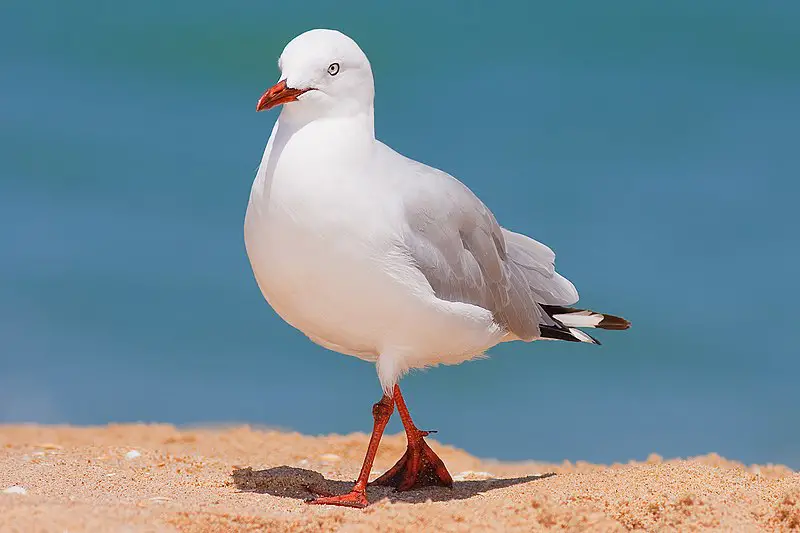
The Silver Gull is a common sight in Australia, especially along the coastlines. It’s smaller than the Pacific Gull and has silver-grey wings with white head and underparts.
Its scientific name is Chroicocephalus novaehollandiae, but it shouldn’t be confused with the Herring Gull which is also called “Silver Gull” in many other languages (Larus argentatus).
During summer months these birds can often be seen around fishing boats scavenging for discarded food or flying low over city parks looking for handouts from humans.
They are highly adaptable to their environment making them quite successful at coexisting near human populations.
These Australian seabirds have been known to live up to 25 years old.
Scientific classification:
| Kingdom | Animalia |
| Phylum | Chordata |
| Class | Aves |
| Order | Charadriiformes |
| Family | Laridae |
| Genus | Chroicocephalus |
| Species | C. novaehollandiae |
Also Featured In: Gulls Species, Silver Birds You Should Know
21. White-Necked Heron
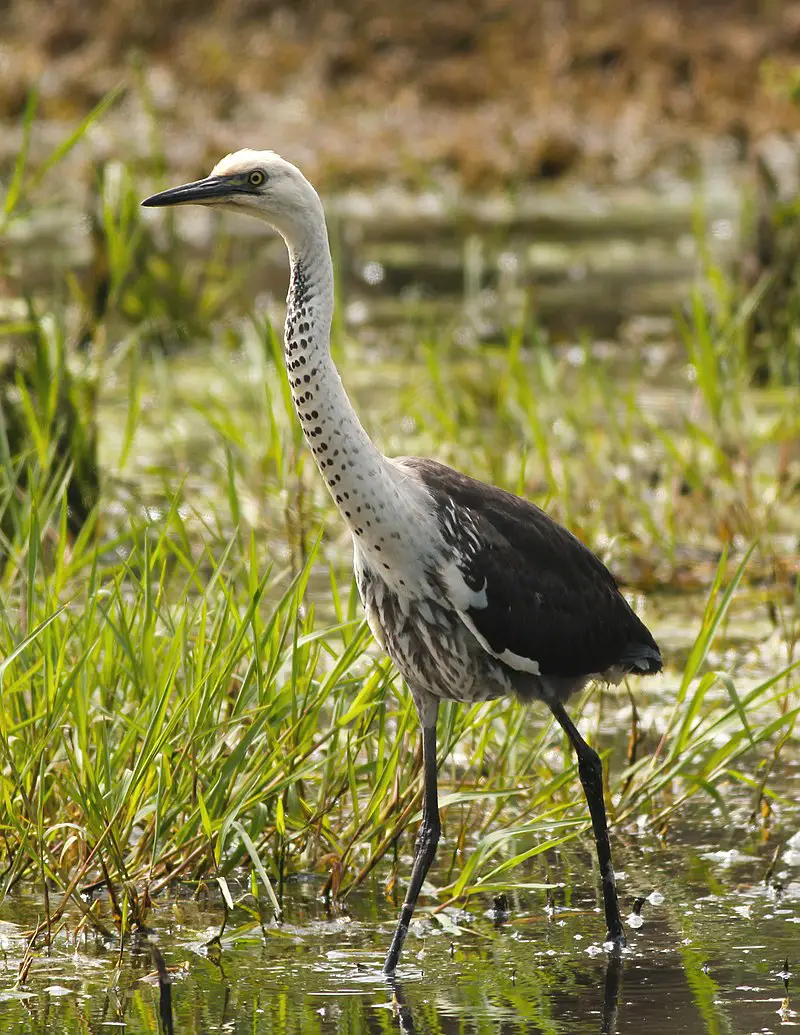
The white-necked heron, or Pacific heron, is a species of large water bird found across much of Australia. It has also been spotted in Indonesia, New Guinea and New Zealand but is rarer in Tasmania.
These birds are nomadic by nature and move from one water source to the next depending on availability.
They have long legs which enable them to wade through shallow waters looking for prey such as fish, crustaceans and insects.
Their feathers are greyish with a distinctive white neck patch that gives these birds their name – they can be seen standing tall at the edge of rivers or lakes watching for movement underwater before diving down gracefully into the depths.
Scientific classification:
| Kingdom | Animalia |
| Phylum | Chordata |
| Class | Aves |
| Order | Pelecaniformes |
| Family | Ardeidae |
| Genus | Ardea |
| Species | A. pacifica |
Also Featured In: Herons Species, Common Townsville Birds
22. Sacred Kingfisher
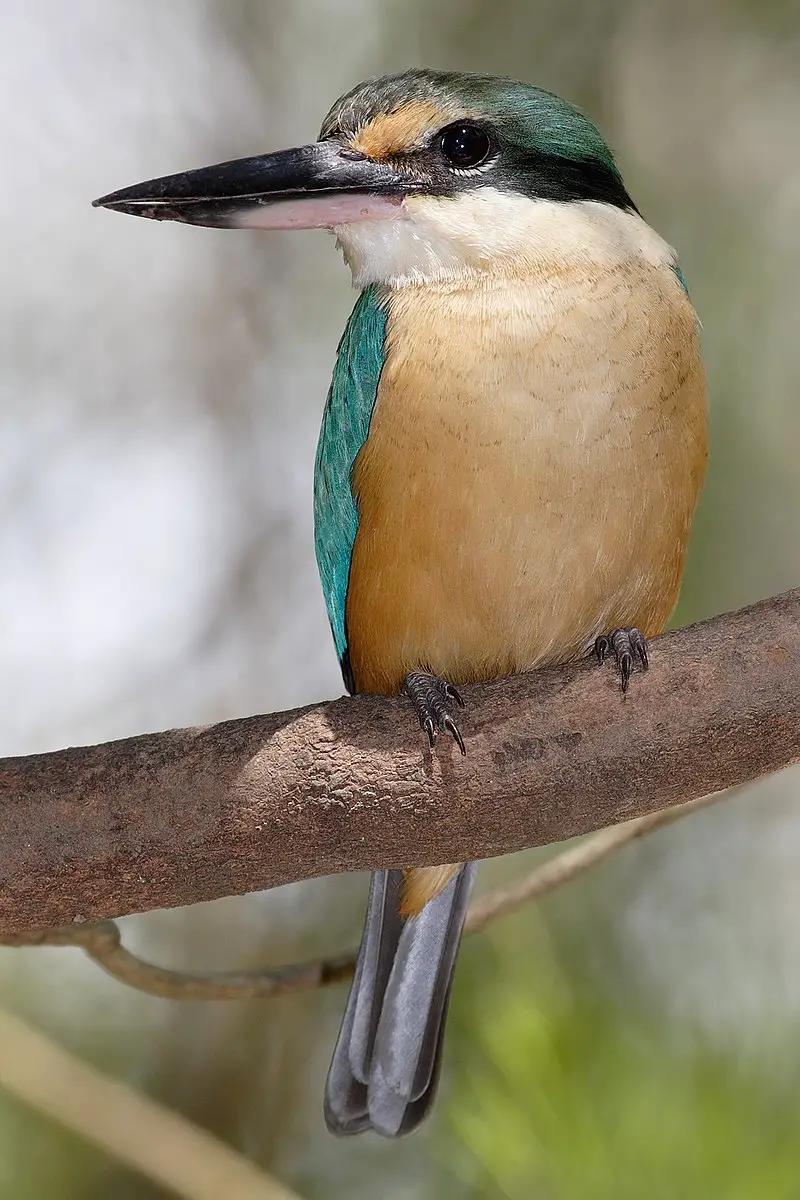
The Sacred Kingfisher is a medium-sized bird found throughout Australia, New Zealand and the western Pacific. It inhabits mangroves, woodlands, forests and river valleys.
Its binomial name Halcyon sanctus was introduced by Nicholas Aylward Vigors and Thomas Horsfield in 1827 when they described an Australian specimen of this species.
The kingfisher has bright blue feathers on its back with striking orange or red underparts depending on their geographical location.
They feed mainly off fish but will also take crustaceans as well as other small aquatic prey like insects.
When breeding season arises these magnificent birds build elaborate nests out of mud pellets inside hollows near water sources making them one of the most unique avian creatures around.
Scientific classification:
| Kingdom | Animalia |
| Phylum | Chordata |
| Class | Aves |
| Order | Coraciiformes |
| Family | Alcedinidae |
| Subfamily | Halcyoninae |
| Genus | Todiramphus |
| Species | T. sanctus |
Also Featured In: Kingfishers Species, Queensland Birds You Should Know
23. Yellow-Tailed Black Cockatoo
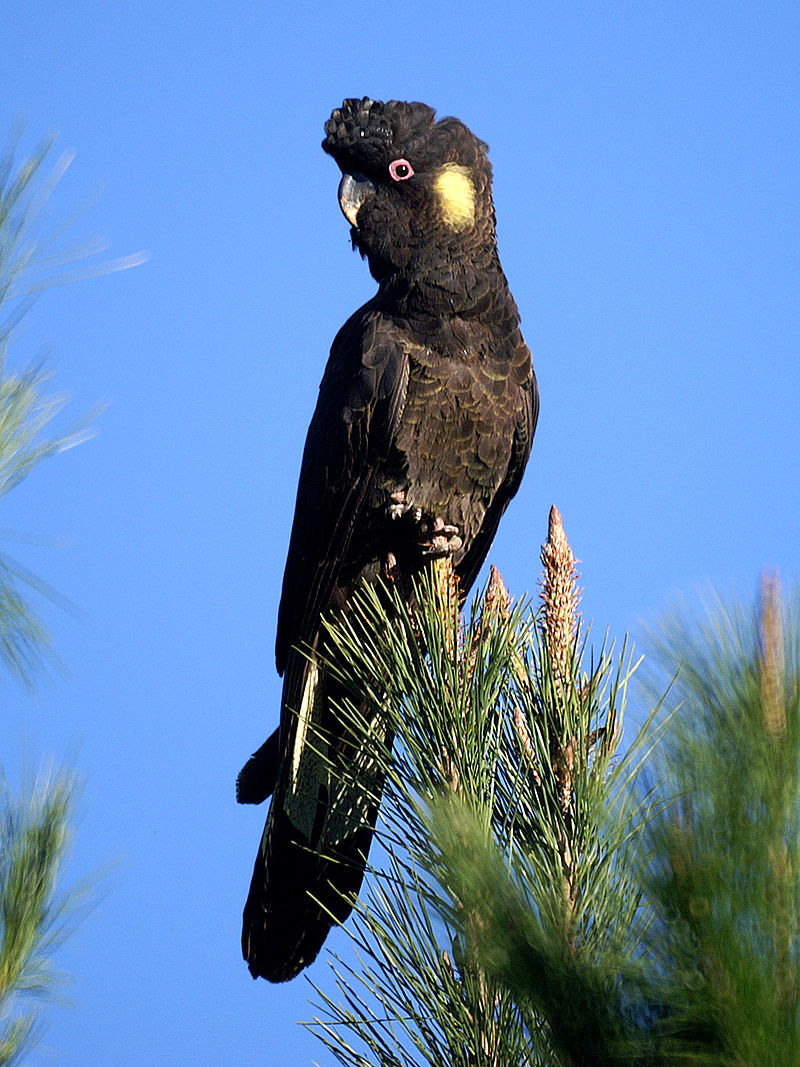
The Yellow-tailed Black Cockatoo is a beautiful bird native to Australia. It measures 55–65 cm in length and has an unmistakable look with its brownish black plumage, yellow cheek patches, short crest on the top of its head and prominent yellow tail band.
The feathers are also edged with yellow giving it a unique scalloped appearance. Males have a striking black beak while females have pink beaks with grey tips – making them easy to tell apart at first glance.
They prefer woodlands but can sometimes also be seen near urban areas as well as open grassy woodlands or forests where they feed on seeds from eucalypts, acacias and banksias among other plants.
They make loud screeching noises when flying which makes them easily identifiable even from afar.
Scientific classification:
| Kingdom | Animalia |
| Phylum | Chordata |
| Class | Aves |
| Order | Psittaciformes |
| Family | Cacatuidae |
| Genus | Zanda |
| Species | Z. funerea |
Also Featured In: Parrots Species, Birds that Live around Victoria
24. Australasian Darter
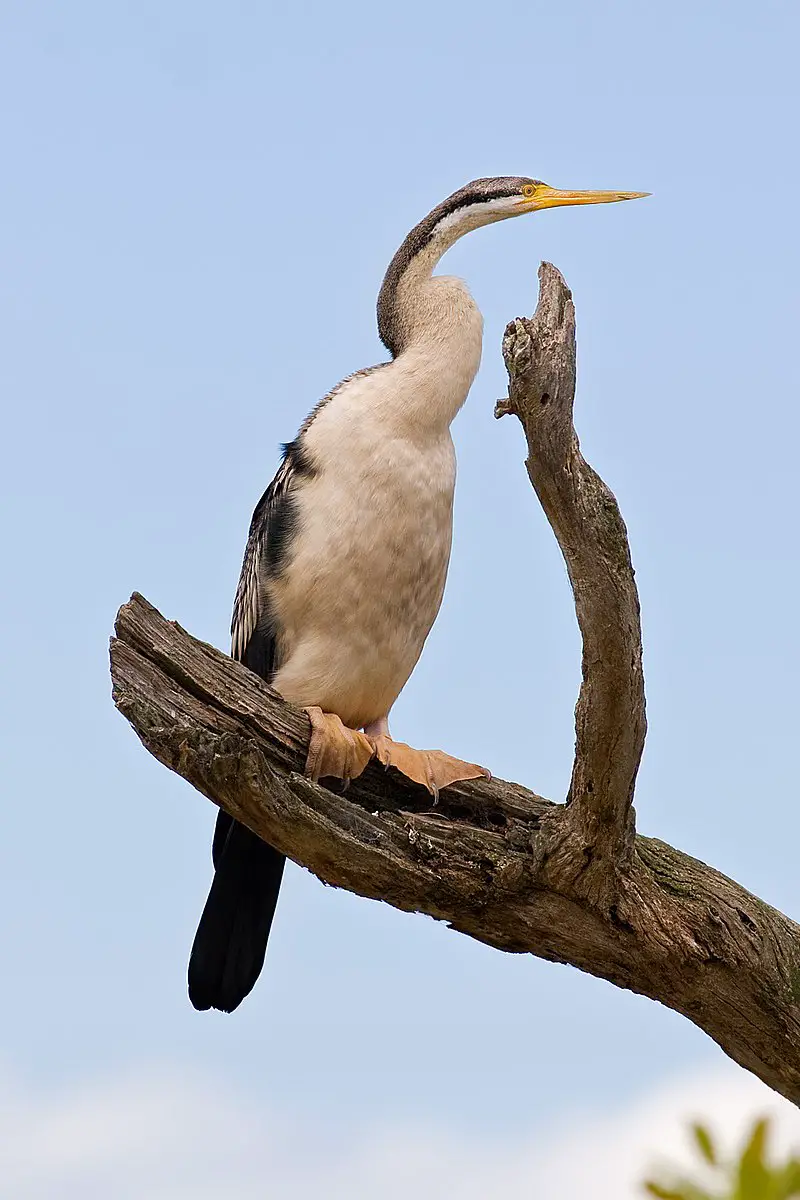
The Australasian Darter, also known as the Australian Darter, is a species of bird in the darter family. It can be found across Australia, Indonesia and Papua New Guinea.
This large bird has an impressive wingspan between 86-94 cm and weighs up to 2.6 kgs.
First discovered by John Gould in 1847, this long necked creature loves to swim and hunt for food underwater before drying its feathers on tree branches or rocks afterwards – like other Anhingidae species do.
They mainly feed on fish but will eat crustaceans too if they are around. With beautiful black plumage with white markings on their wings and tail these birds stand out from most others due to their unique style when it comes to fishing.
Scientific classification:
| Kingdom | Animalia |
| Phylum | Chordata |
| Class | Aves |
| Order | Suliformes |
| Family | Anhingidae |
| Genus | Anhinga |
| Species | A. novaehollandiae |
Also Featured In: Cormorant Species, Birds that Found in Kakadu National Park
25. Welcome Swallow
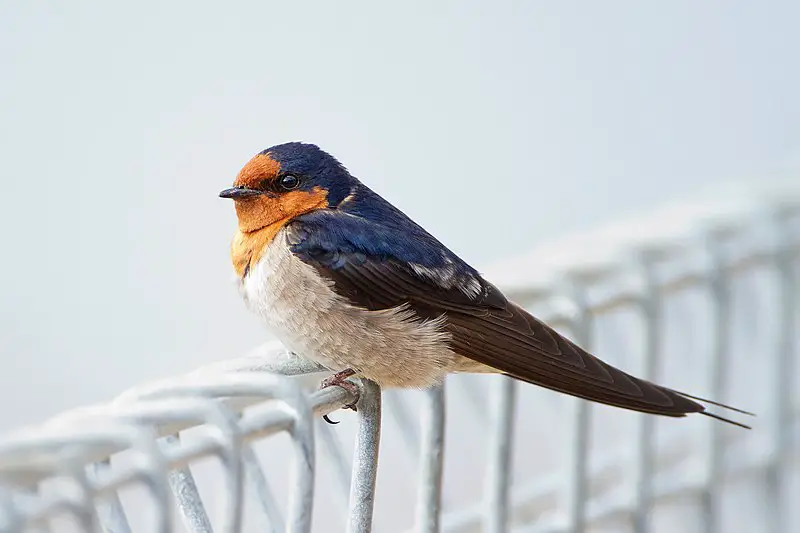
The Welcome Swallow (Hirundo neoxena) is a small passerine bird in the swallow family, native to Australia and nearby islands.
It was self-introduced into New Zealand in the mid twentieth century and is often considered conspecific with the Pacific swallow.
This species breeds mainly throughout southern and eastern Australia across various habitats such as woodlands, open countrysides, grasslands, marshes and coastal areas.
They are most commonly seen near human settlements like farmhouses or parks where they build their distinctive mud nests under eaves of buildings or on bridges.
The adults have steel-blue upperparts with pale rufous undersides while their throat has white stripes that extend down onto its breast feathers giving it a very attractive look.
Scientific classification:
| Kingdom | Animalia |
| Phylum | Chordata |
| Class | Aves |
| Order | Passeriformes |
| Family | Hirundinidae |
| Genus | Hirundo |
| Species | H. neoxena |
Also Featured In: Swallows Species, Sydney Birds You Need to See
26. Grey Teal
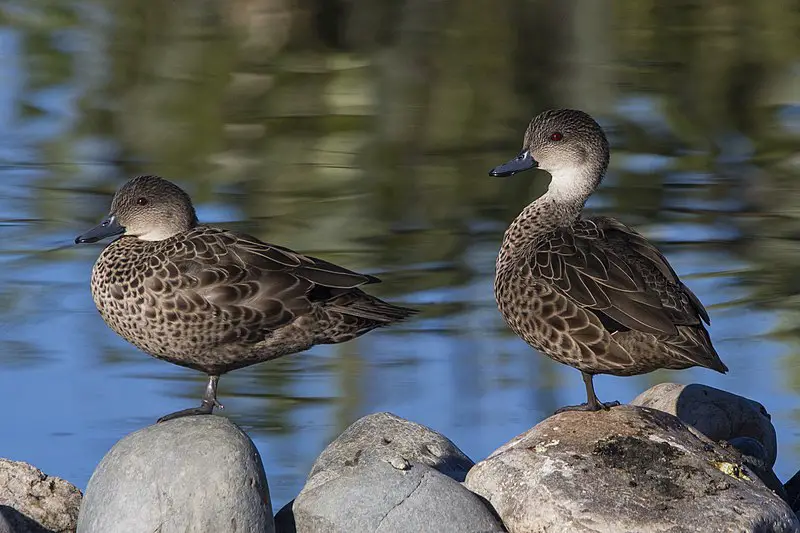
The Grey Teal is a beautiful dabbling duck native to Australia and New Zealand. It can be identified by its mottled brown feathers, white and green flashes on the wings and most noticeably, an adult male’s crimson coloured iris in its eyes.
Males and females share the same colouration unlike other ducks of similar species which have different feather patterns between sexes.
The Grey Teal prefers open wetlands for habitat where it feeds mainly on aquatic plants but also small crustaceans or insects as part of their diet.
They are usually found in family groups with one female accompanied by several males during breeding season when courtship begins until nesting occurs around May-June time frame each year depending upon location.
Scientific classification:
| Kingdom | Animalia |
| Phylum | Chordata |
| Class | Aves |
| Order | Anseriformes |
| Family | Anatidae |
| Genus | Anas |
| Species | A. gracilis |
Also Featured In: birds of teal, Native Birds Of Mackay
27. Torresian Crow
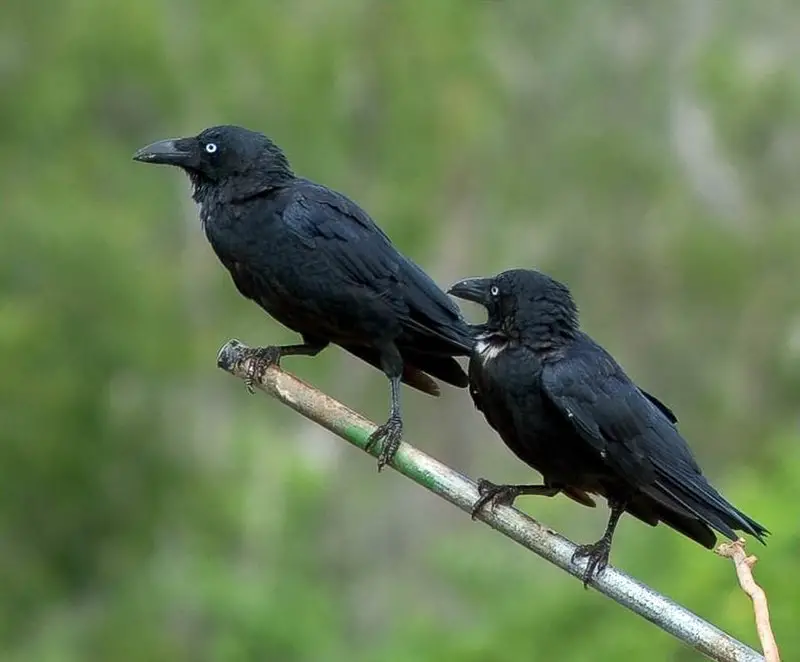
The Torresian crow, also known as the Australian crow or Papuan crow, is a black-plumaged bird with white irises.
It can be found in the north and west of Australia as well as islands in Indonesia and Papua New Guinea.
The bird species possesses a robust build, and the base of its feathers on the head and neck are white. These crows are slightly larger than other crow species.
They belong to the passerine bird family and have a unique beak and mouth.
Although they are widely distributed, some populations of the Torresian crow may be declining due to habitat loss and other threats.
Overall, the Torresian crow is an interesting bird that has adapted to survive in a range of environments.
Scientific classification:
| Kingdom | Animalia |
| Phylum | Chordata |
| Class | Aves |
| Order | Passeriformes |
| Family | Corvidae |
| Genus | Corvus |
| Species | C. orru |
Also Featured In: Birds that Charles Darwin Studied,
28. Red-Browed Finch
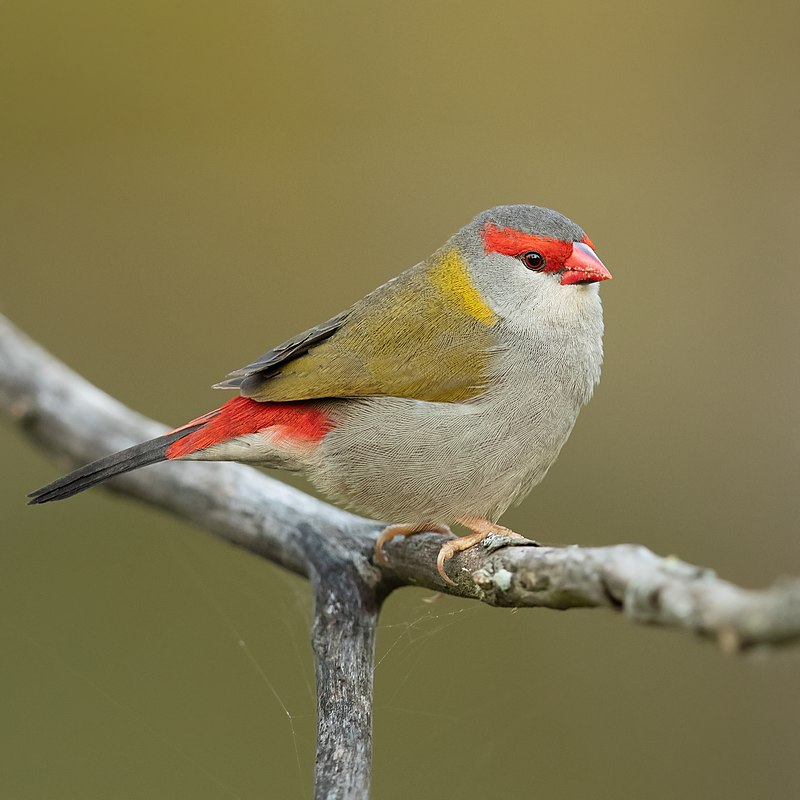
The Red-browed Finch is an estrildid finch that is found along the east coast of Australia. It can also be found in French Polynesia.
The bird prefers to live in temperate forest and dry savannah habitats, but can also be found in dry forests and mangroves in tropical regions.
The defining features of the species include a bright red stripe above the eye, and a vibrant red rum. Despite its small size, the Red-browed Finch is quite distinct and easy to identify.
These birds are known for their active lifestyles and often travel in flocks. They primarily feed on seeds, but may also consume insects and fruit.
As an introduced species, the Red-browed Finch has thrived in new environments, making it a common sight across multiple regions.
Scientific classification:
| Kingdom | Animalia |
| Phylum | Chordata |
| Class | Aves |
| Order | Passeriformes |
| Family | Estrildidae |
| Genus | Neochmia |
| Species | N. temporalis |
Also Featured In: Birds that Live in Gold Coasts, Small Birds that Live in New South Wales
29. Pied Currawong
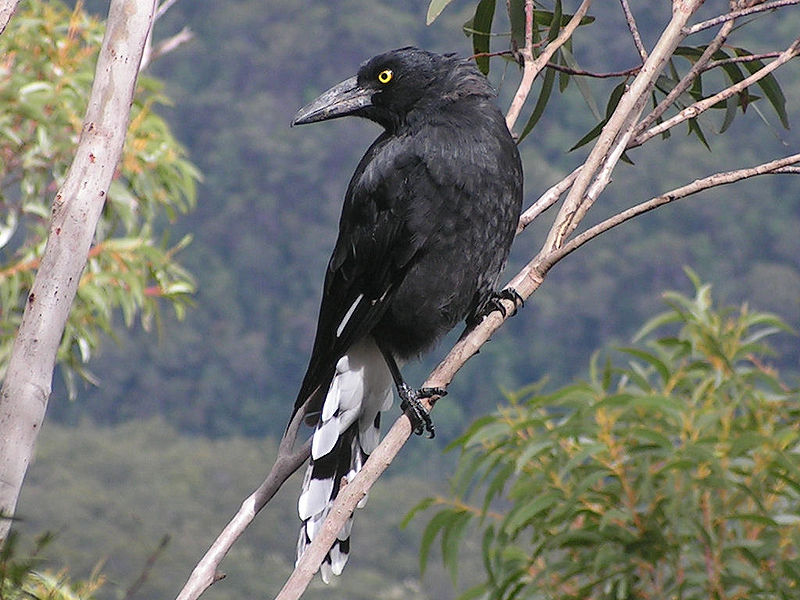
The Pied currawong is a black passerine bird found in eastern Australia and Lord Howe Island. It is closely related to the butcherbirds and Australian magpie.
This crow-like bird is about 48 cm long and has black or sooty grey-black plumage. It is a robust bird and has six recognized subspecies.
Scientific classification:
| Kingdom | Animalia |
| Phylum | Chordata |
| Class | Aves |
| Order | Passeriformes |
| Family | Artamidae |
| Genus | Strepera |
| Species | S. graculina |
Also Featured In: Common Melbourne Birds,
30. Grey Butcherbird
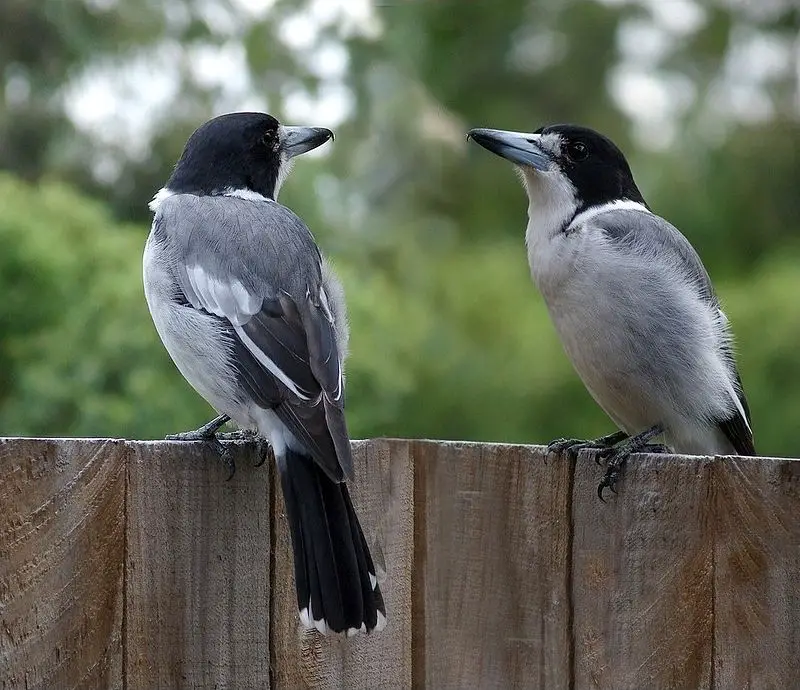
The Grey butcherbird is a species of bird found exclusively in Australia. It can be found in several different environments, including semi-arid and temperate zones.
The bird has a unique and distinctive birdsong. The Grey butcherbird is absent from the deserts of central Australia and the monsoon tropics of the north. It appears to be adaptable to its surroundings.
Scientific classification:
| Kingdom | Animalia |
| Phylum | Chordata |
| Class | Aves |
| Order | Passeriformes |
| Family | Artamidae |
| Genus | Cracticus |
| Species | C. torquatus |
Also Featured In: South Australian Birds, Birds that You’ll find in Perth
31. Powerful Owl
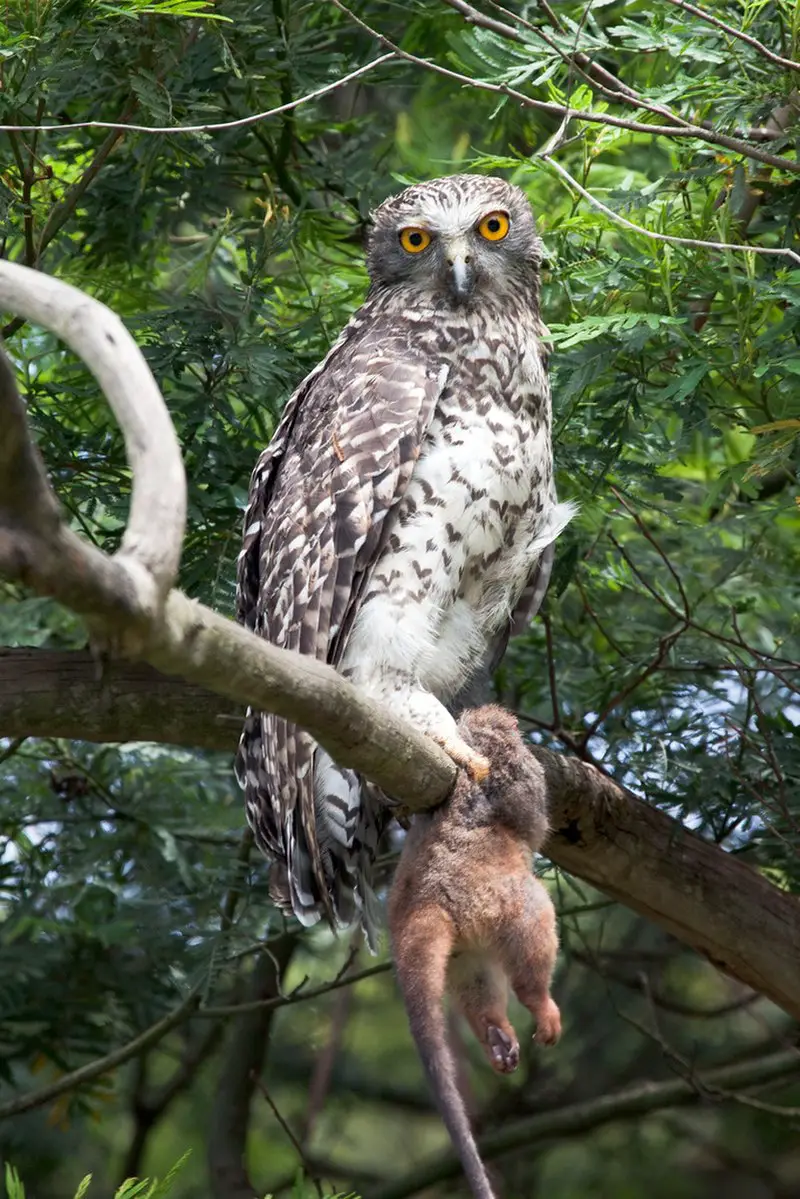
The Powerful Owl, also known as the Powerful Boobook, is the largest owl species in Australia. It can be found in both coastal areas and the Great Dividing Range, though it is rarely found more than 120 miles inland.
These owls are apex predators in their region, hunting a variety of prey. Due to habitat loss, they are listed as a species of concern.
Despite this, they are still able to thrive in some urban areas as long as there is a stable food source available.
With their striking appearance and powerful talons, the Powerful Owl is a magnificent bird and an important part of the Australian ecosystem.
Scientific classification:
| Kingdom | Animalia |
| Phylum | Chordata |
| Class | Aves |
| Order | Strigiformes |
| Family | Strigidae |
| Genus | Ninox |
| Species | N. strenua |
32. Australian White Ibis
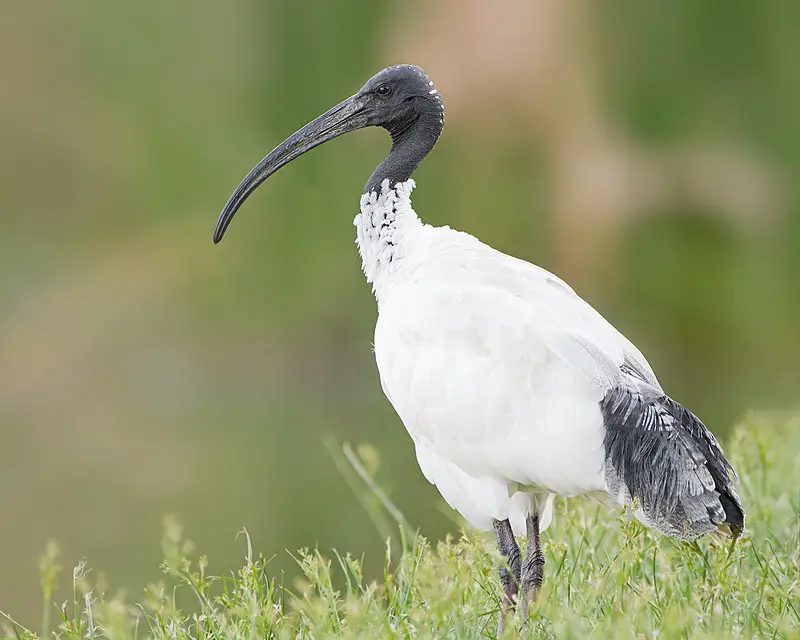
The Australian white ibis is a native wading bird of Australia. With its predominantly white plumage and long downcurved bill, it is easily recognized.
The bird is often found foraging for food on open grasslands, pastures and urban areas such as parks and gardens.
Despite being closely related to the African sacred ibis, the Australian white ibis is a separate species. It has a bare, black head and black legs.
The bird is well adapted to urban environments and often scavenges for food from waste bins or on streets.
While it has been subjected to negative perceptions due to its scavenging behavior, it remains an important member of the Australian ecosystem.
Scientific classification:
| Kingdom | Animalia |
| Phylum | Chordata |
| Class | Aves |
| Order | Pelecaniformes |
| Family | Threskiornithidae |
| Genus | Threskiornis |
| Species | T. molucca |
Also Featured In: Water Birds Live around Us, Most Common Western Australia Birds
33. Australasian Grebe
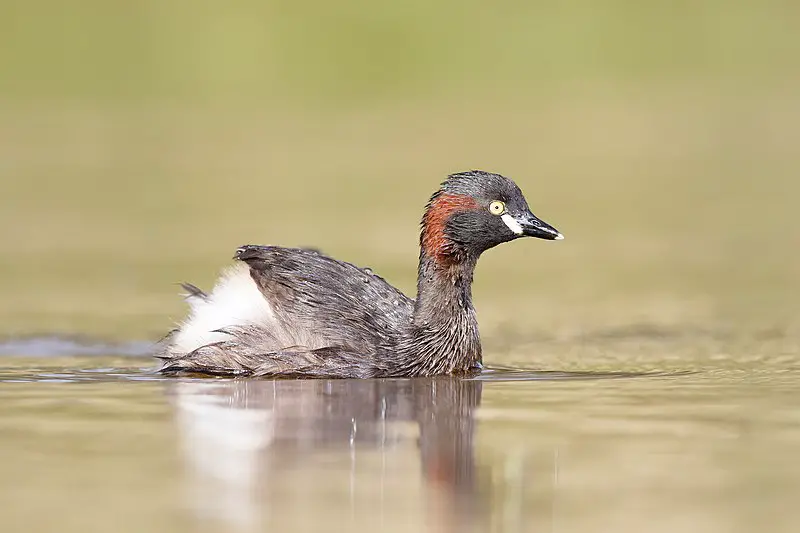
The Australasian grebe is a small waterbird that is frequently seen on fresh water lakes and rivers in Australia, New Zealand, and the Pacific islands. It is one of the smallest members of the grebe family, measuring only 25-27 cm in length.
The bird has a dark brown upper body and a glossy-black head and neck, making it quite striking in appearance.
Both male and female Australasian grebes look alike, and the species is known for its strong swimming and diving abilities.
Due to its reliance on freshwater ecosystems, the Australasian grebe is highly vulnerable to habitat loss and other environmental threats.
Conservation efforts are underway to protect this unique and important bird species.
Scientific classification:
| Kingdom | Animalia |
| Phylum | Chordata |
| Class | Aves |
| Order | Podicipediformes |
| Family | Podicipedidae |
| Genus | Tachybaptus |
| Species | T. novaehollandiae |
Also Featured In: New South Wales Birds You Need to See, Java Birds You Should Know
34. Whistling Kite
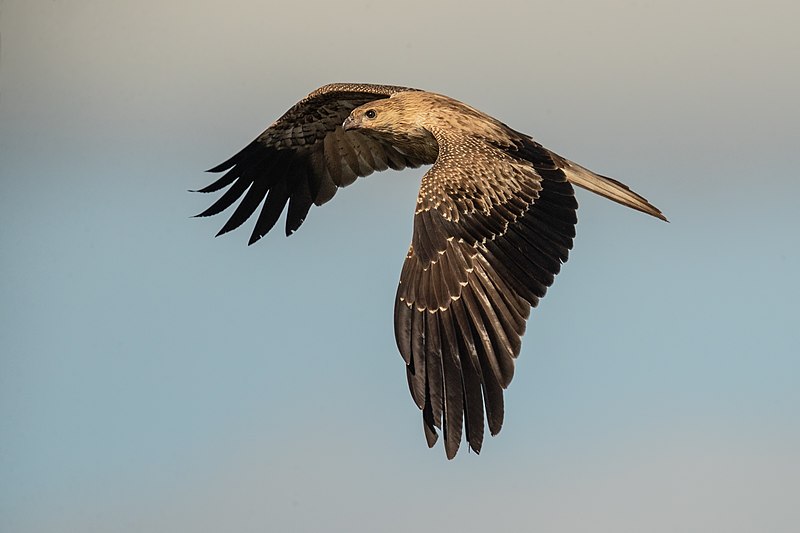
The Whistling Kite is a diurnal raptor that is commonly found in Australia, New Caledonia, and much of New Guinea.
Also known as the whistling eagle or whistling hawk, this medium-sized bird is named after its distinct and melodious whistle-like call that it often produces while flying.
The Whistling Kite is known for its unique hunting strategy where it circles the skies looking out for prey, before diving down and snatching it up.
It is a powerful flier and can cover great distances in search of food. The bird prefers to live near water bodies as it is more likely to find prey there.
Its diet consists mostly of small animals such as rodents, reptiles, fish, and insects. The Whistling Kite is an important species to the ecosystem as it helps control pest populations and maintain the balance of the food chain.
Scientific classification:
| Kingdom | Animalia |
| Phylum | Chordata |
| Class | Aves |
| Order | Accipitriformes |
| Family | Accipitridae |
| Genus | Haliastur |
| Species | H. sphenurus |
35. Little Friarbird
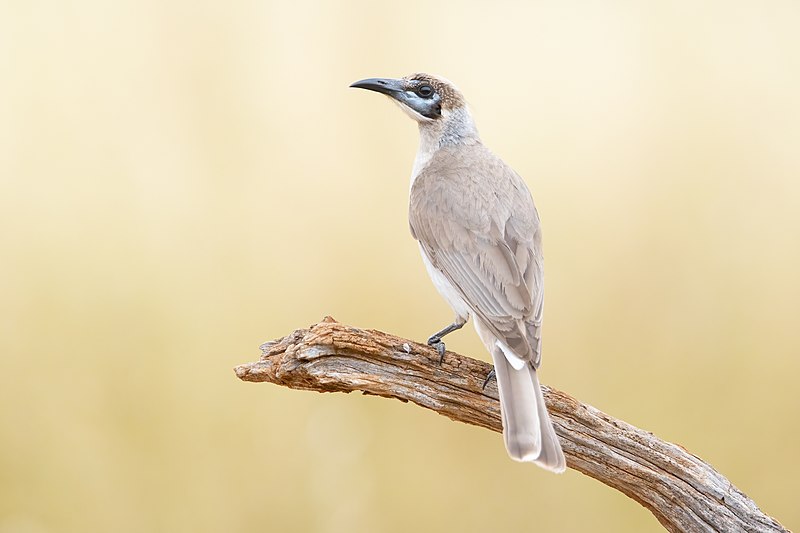
The Little Friarbird, also called Yellow-throated Friarbird, is a small bird native to northern and eastern Australia and southern Papua New Guinea. This species of bird belongs to the Philemon genus and is the smallest of the friarbirds.
It lives a very active life, often seen chasing other honeyeaters and can be quite vocal.
Despite its small size, it is easy to spot and recognize due to its distinct yellow throat feathers. This bird species has adapted well to its environment and is a common sight in its range.
The Little Friarbird is a fascinating bird and is a great addition to any bird watching excursion in Australia or southern Papua New Guinea.
Scientific classification:
| Kingdom | Animalia |
| Phylum | Chordata |
| Class | Aves |
| Order | Passeriformes |
| Family | Meliphagidae |
| Genus | Philemon |
| Species | P. citreogularis |
36. Black-Faced Cuckooshrike
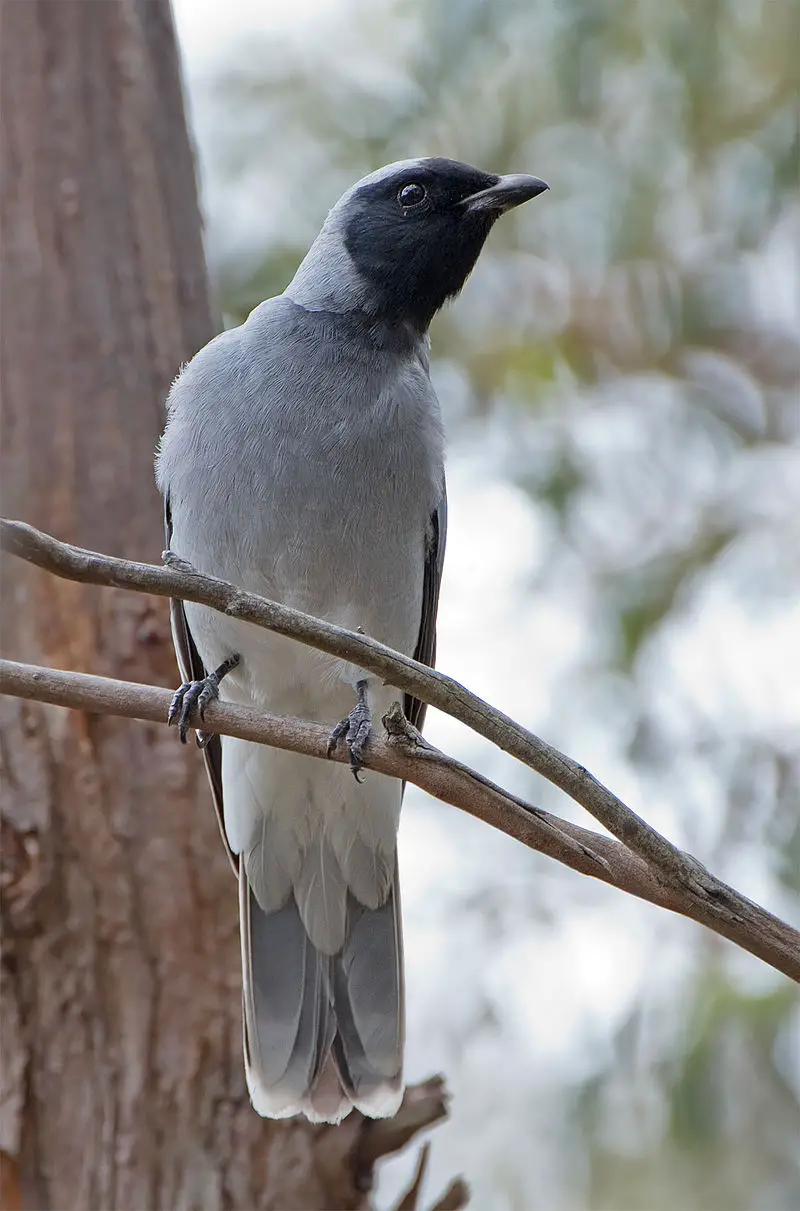
The Black-faced cuckooshrike, found in Australia and southern New Guinea, is a protected species under Australian law.
These birds are omnivorous and commonly seen in wooded habitats, with the exception of rainforests.
Despite this, they are also sometimes found in urban areas. The Black-faced cuckooshrike is a passerine bird and is known for its distinctive black facial markings.
Scientific classification:
| Kingdom | Animalia |
| Phylum | Chordata |
| Class | Aves |
| Order | Passeriformes |
| Family | Campephagidae |
| Genus | Coracina |
| Species | C. novaehollandiae |
37. Pacific Black Duck
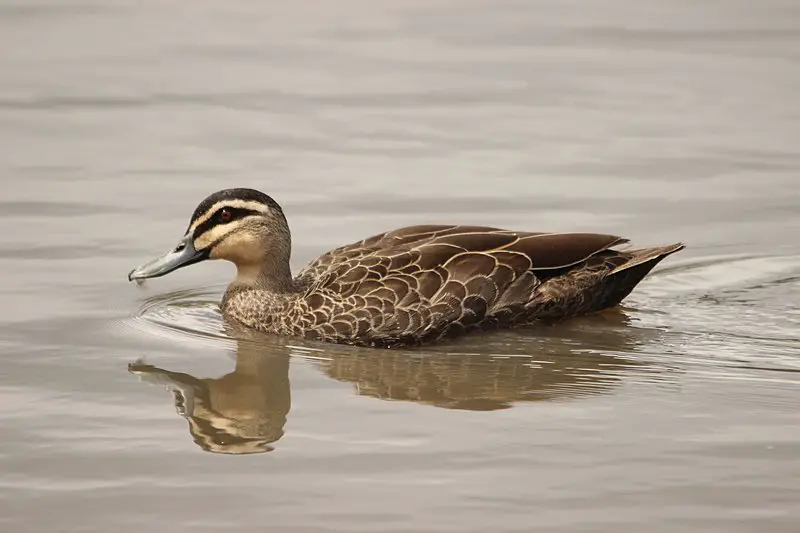
The Pacific black duck, also referred to as the gray duck in New Zealand, is a type of dabbling duck that can be found in numerous countries ranging from Indonesia to French Polynesia.
Its scientific name is Anas superciliosa. In New Zealand, the duck is often called by its Maori name, pārera.
The Pacific black duck lives in a variety of habitats, such as wetlands, marshes, and rice paddies.
It has distinctive features, including a dark body with white specks, a slightly curved beak, and a light-colored crown.
This duck is a common sight in its range, and it feeds on a variety of items such as insects, small fish, and seeds.
The Pacific black duck is an important part of the ecosystem and can even be hunted for food in some areas.
Scientific classification:
| Kingdom | Animalia |
| Phylum | Chordata |
| Class | Aves |
| Order | Anseriformes |
| Family | Anatidae |
| Genus | Anas |
| Species | A. superciliosa |
Also Featured In: Black Birds in New Zealand,
38. Olive-Backed Oriole
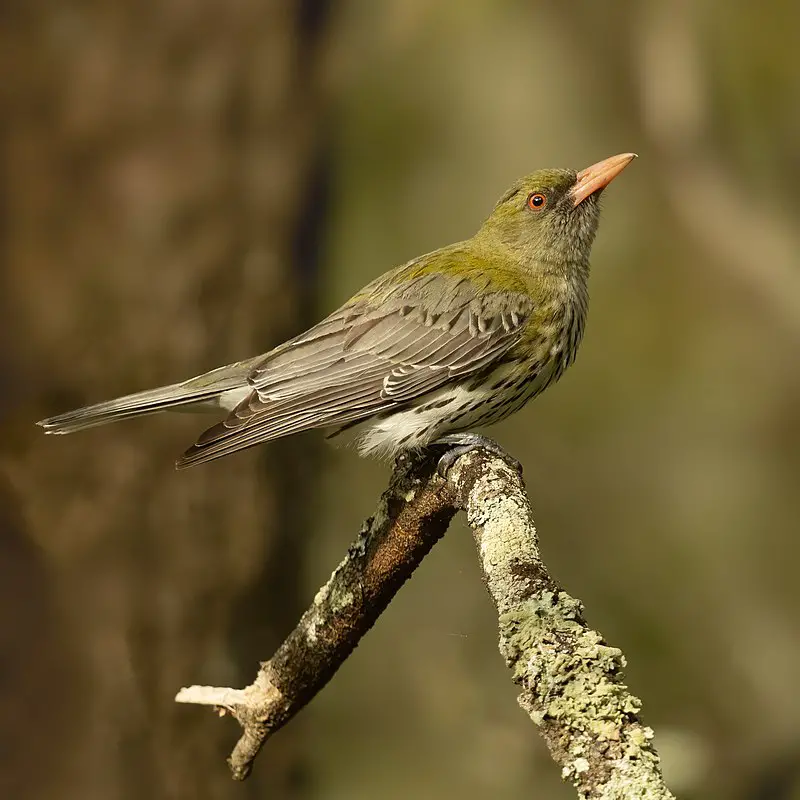
The olive-backed oriole is a medium-sized bird found in northern and eastern Australia and south-central New Guinea. It is known for its noisy and conspicuous behavior, making it easy to spot.
This bird was first described by John Latham in 1801, and is the most widespread Australasian oriole. With its distinctive white belly, this bird is a common sight among trees and bushes.
The olive-backed oriole belongs to the Coracias genus and has four sub-species.
It is a passerine bird that is often vocal, producing a range of calls and songs. If you’re ever in northern or eastern Australia or south-central New Guinea, keep an eye out for the olive-backed oriole and its beautiful plumage.
Scientific classification:
| Kingdom | Animalia |
| Phylum | Chordata |
| Class | Aves |
| Order | Passeriformes |
| Family | Oriolidae |
| Genus | Oriolus |
| Species | O. sagittatus |
Also Featured In: Birds that Live in Sunshine Coast,
39. Hardhead
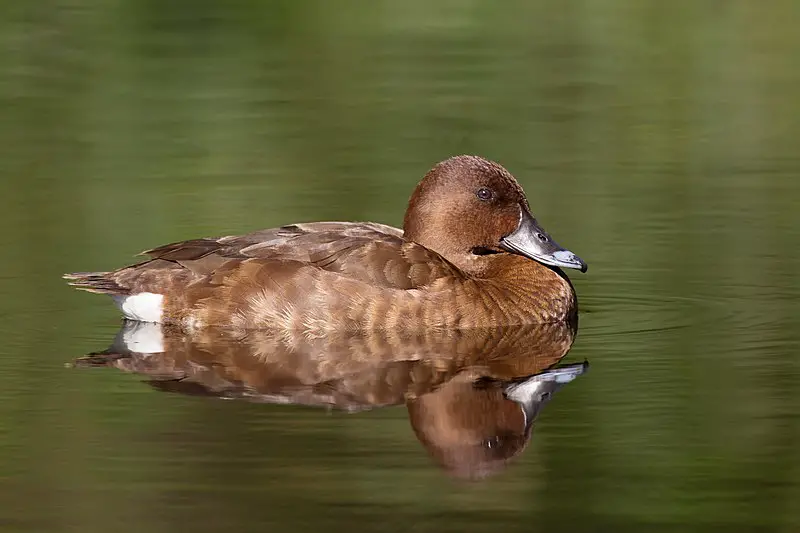
The Hardhead bird, scientifically known as Aythya australis, is the only genuine diving duck found in Australia. Its common name, “hardhead,” refers to the taxidermists’ difficulty processing its head, not its skull’s density.
These birds are typically found in wet coastal regions of Australia, mainly in the southeast. They have white eyes and are usually grey or black with a bluish-black bill.
As diving ducks, Hardheads dive deep into the water to forage for aquatic plants, mollusks, and invertebrates.
They are relatively quiet birds with a harsh, low quack sound. Hardheads play an important role in aquatic ecosystems as they help to control the growth of certain plants, keep waterways clean, and are preyed upon by larger birds and reptiles.
Scientific classification:
| Kingdom | Animalia |
| Phylum | Chordata |
| Class | Aves |
| Order | Anseriformes |
| Family | Anatidae |
| Genus | Aythya |
| Species | A. australis |
40. Straw-Necked Ibis
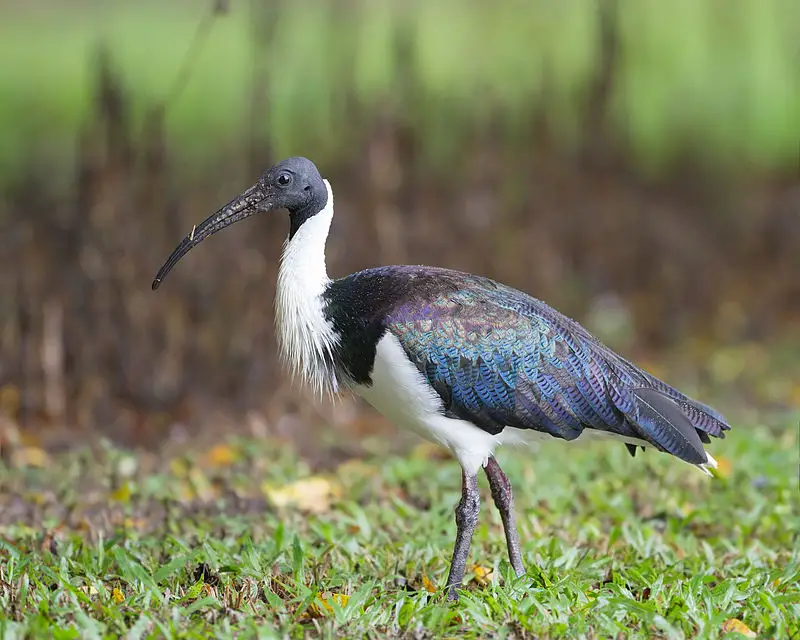
The Straw-necked ibis is a large bird that belongs to the Threskiornithidae family. It can be found in different parts of the world such as Australia, New Guinea, and Indonesia.
These birds are easily identifiable by their distinctive features such as their long, down-curved black bill, bare black head, and straw-like feathers on their necks. They can grow up to 76 cm in length and are known to be active during the day.
The Straw-necked ibis feeds on a variety of things such as insects, frogs, fish, and small reptiles.
They are known for having a loud call that can be heard from a distance. These birds are social creatures that can often be seen in flocks of up to 100 individuals.
The Straw-necked ibis is a beautiful bird that plays an important role in the ecosystem.
Scientific classification:
| Kingdom | Animalia |
| Phylum | Chordata |
| Class | Aves |
| Order | Pelecaniformes |
| Family | Threskiornithidae |
| Genus | Threskiornis |
| Species | T. spinicollis |
41. Spotted Pardalote
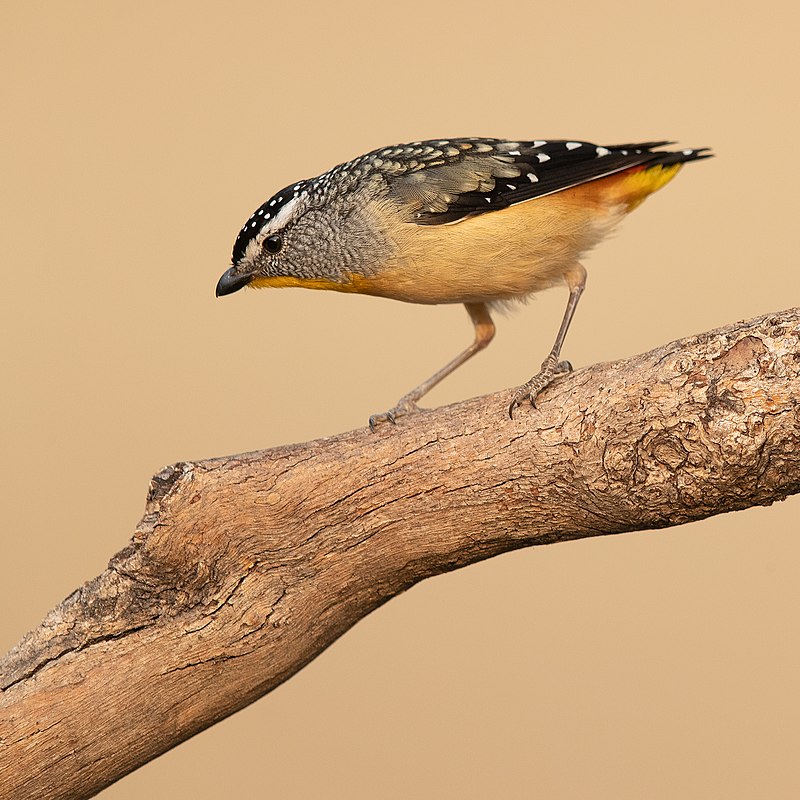
The spotted pardalote is a tiny bird found in various parts of Australia. It measures only 8 to 10 centimetres in length, making it one of the smallest birds in the country.
This colourful bird is also known as the diamondbird due to its bright plumage. Even though it is common in fertile regions of Australia, it is rarely seen up close, making it challenging to identify.
It can be found in the east coast, the south-east, and the south-west corner of the country.
Despite its small size, the spotted pardalote is a vocal bird with a distinctive call. Due to their small size, they are particularly susceptible to harsh weather and habitat destruction.
These birds play a vital role in various ecosystems through their feeding behaviour and are essential seed distributors.
Scientific classification:
| Kingdom | Animalia |
| Phylum | Chordata |
| Class | Aves |
| Order | Passeriformes |
| Family | Pardalotidae |
| Genus | Pardalotus |
| Species | P. punctatus |
42. Striated Pardalote
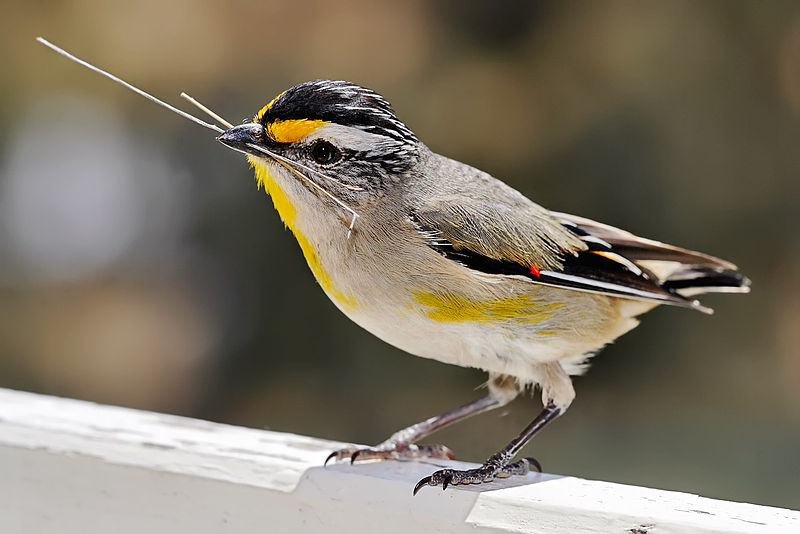
The Striated pardalote, also known as pickwick, wittachew or chip-chip, is a small, short-tailed bird. It is the most common and least colorful of the four pardalote species, and is frequently heard foraging in treetops for small creatures like lerps.
The Striated pardalote is more often heard than seen due to its inconspicuous appearance. Four distinct species of the pardalote were initially identified, but the Striated pardalote can be recognized by its physical characteristics.
Despite its lack of dazzling colors, this bird is a beloved sight for birdwatchers, and contributes to the biodiversity of the local ecosystem.
Scientific classification:
| Kingdom | Animalia |
| Phylum | Chordata |
| Class | Aves |
| Order | Passeriformes |
| Family | Pardalotidae |
| Genus | Pardalotus |
| Species | P. striatus |
Also Featured In: Birds that Live in Kangaroo Island,
43. Mistletoebird
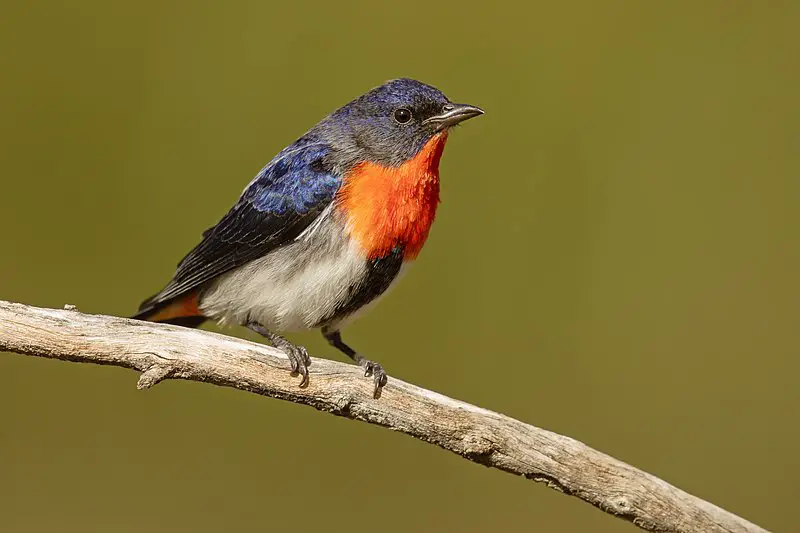
The mistletoebird is a small, colorful bird found in Australia and the eastern Maluku Islands. It feeds mainly on the berries of the parasitic mistletoe and plays a role in the plant’s reproduction by distributing its seeds.
This bird is also known as the mistletoe flowerpecker due to its habit of gathering soft materials to create its nest, which is shaped like a small purse.
The male mistletoebird has a bright red head and chest, while the female has olive-green plumage with a reddish patch on its throat.
Despite its size, this bird has a loud and melodious song. The mistletoebird’s distribution across much of Australia makes it a familiar sight to many Australians, particularly during the holiday season when mistletoe is used as a festive decoration.
Scientific classification:
| Kingdom | Animalia |
| Phylum | Chordata |
| Class | Aves |
| Order | Passeriformes |
| Family | Dicaeidae |
| Genus | Dicaeum |
| Species | D. hirundinaceum |
Also Featured In: Birds of Far North Queensland,
44. Pied Butcherbird
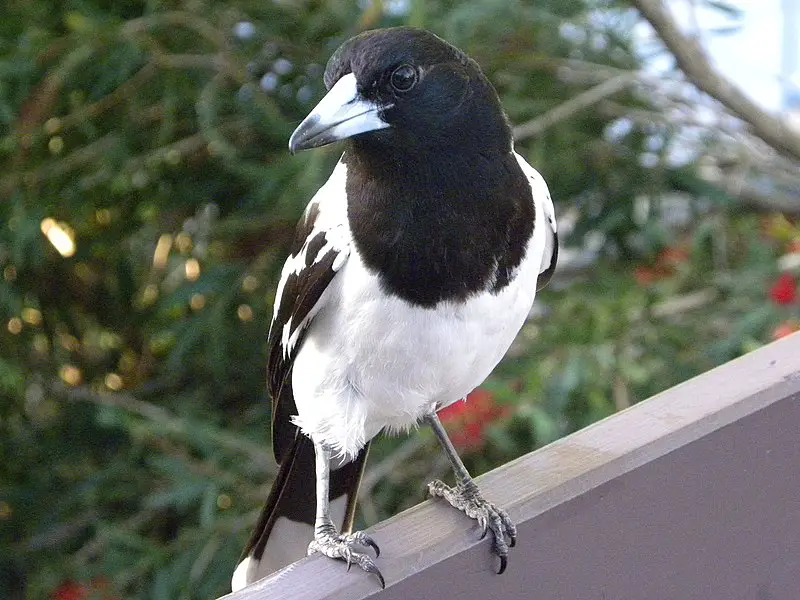
The Pied Butcherbird is a native Australian songbird that measures around 28 to 32 cm in length.
Its striking black and white plumage includes a black hood around its head and throat, as well as black tail and wings, while its neck, outer wings, and underparts are white.
Its long, hook-shaped bill is used for catching prey, usually insects or small mammals. This bird was first described by John Gould in 1837.
The Pied Butcherbird is known for its beautiful, melodious song, often performed in groups or pairs.
The species is common in woodlands and forests across much of Australia, and has successfully adapted to urban and suburban environments.
The juveniles have a more subdued plumage compared to the adults, with a brownish-grey coloration replacing the black feathers.
Scientific classification:
| Kingdom | Animalia |
| Phylum | Chordata |
| Class | Aves |
| Order | Passeriformes |
| Family | Artamidae |
| Genus | Cracticus |
| Species | C. nigrogularis |
45. Spangled Drongo
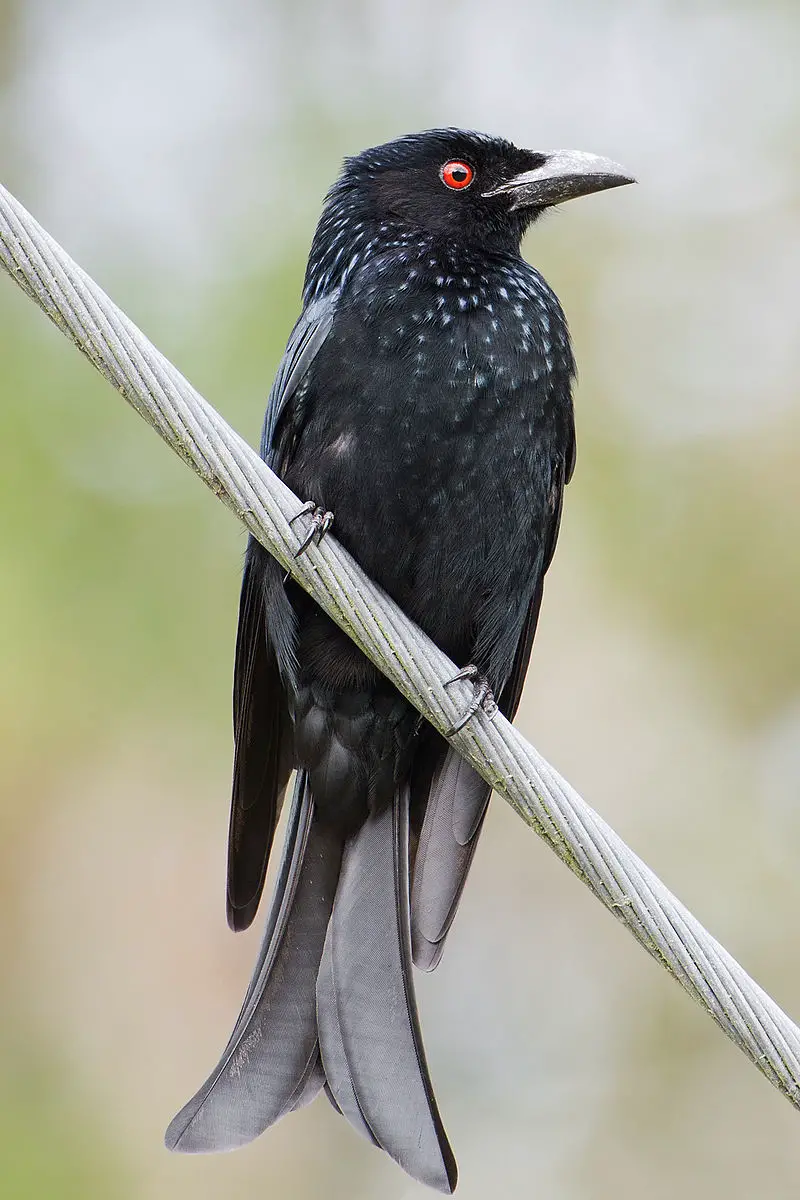
The Spangled drongo is a unique bird found only in Australia. Its black plumage with iridescent shades and forked tail make it easy to identify. It feeds on small animals and insects.
Its call is varied and complex, as it can mimic sounds in its environment. During late spring, it arrives in Queensland to breed in high places.
The Spangled drongo is a fascinating bird for birdwatchers and ornithologists in Australia.
Scientific classification:
| Kingdom | Animalia |
| Phylum | Chordata |
| Class | Aves |
| Order | Passeriformes |
| Family | Dicruridae |
| Genus | Dicrurus |
| Species | D. bracteatus |
Also Featured In: Pet Birds that Live in India,
46. Pale-Headed Rosella
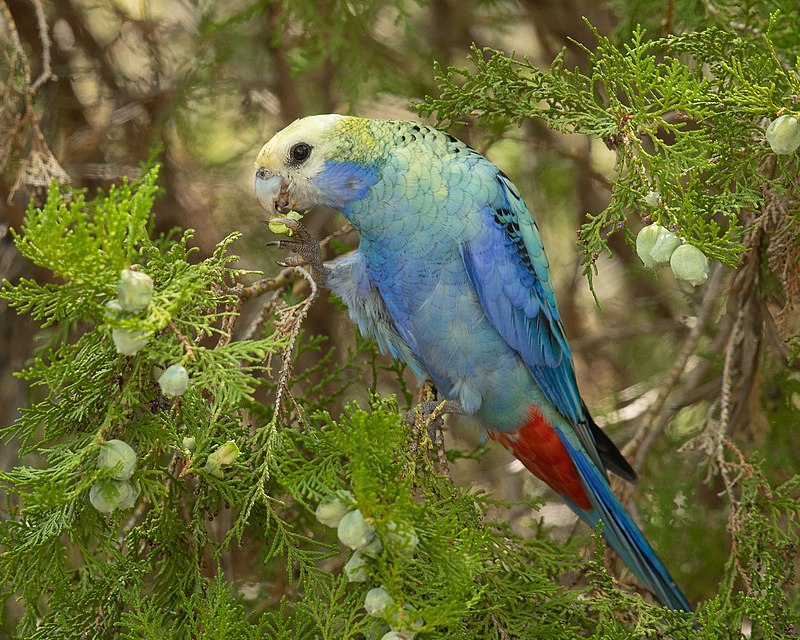
The Pale-headed rosella is a beautiful parrot found in northeastern Australia. This bird is a moderate-size parrot with a mostly pale yellow head, white cheeks, and blue underparts.
Its back is scalloped with black and gold, making it a stunning sight. While some experts consider it to be the same as the eastern rosella, two subspecies of the Pale-headed rosella are recognized.
These birds are known for their intelligence and are popular among bird lovers. They make excellent pets due to their affectionate nature, and with proper care, can live for up to 20 years.
In the wild, they feed on seeds, fruits, and insects, and can be found in open woodlands, forest edges, and urban areas.
Overall, the Pale-headed rosella is a delightful and fascinating bird to observe and interact with.
Scientific classification:
| Kingdom | Animalia |
| Phylum | Chordata |
| Class | Aves |
| Order | Psittaciformes |
| Family | Psittaculidae |
| Genus | Platycercus |
| Species | P. adscitus |
47. Black-Shouldered Kite
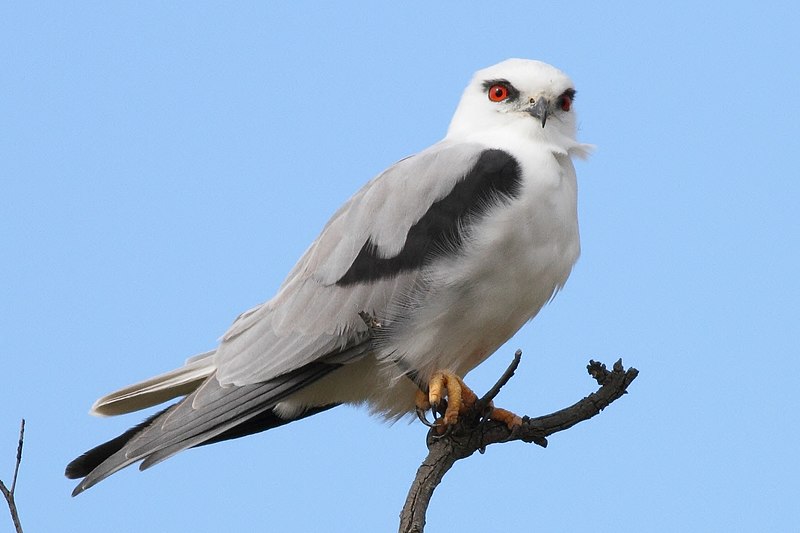
The Black-shouldered kite is a bird of prey that is found throughout Australia in open habitats. It is about 35 cm in length and has a wingspan of approximately 80 cm.
This species resembles others found in Africa, Eurasia, and North America. Despite its name, it is not closely related to the black-winged kite.
Instead, it belongs to the genus Elanus, which includes three other species.
The Black-shouldered kite has a distinctive pale grey head and body, with black shoulders and wings. It feeds mainly on small mammals, such as rodents and insects.
Although it is not considered threatened, habitat loss through land clearing and degradation poses a significant threat to its future existence.
This bird is an important part of Australia’s ecosystem and should be protected.
Scientific classification:
| Kingdom | Animalia |
| Phylum | Chordata |
| Class | Aves |
| Order | Accipitriformes |
| Family | Accipitridae |
| Genus | Elanus |
| Species | E. axillaris |
48. Golden-Headed Cisticola
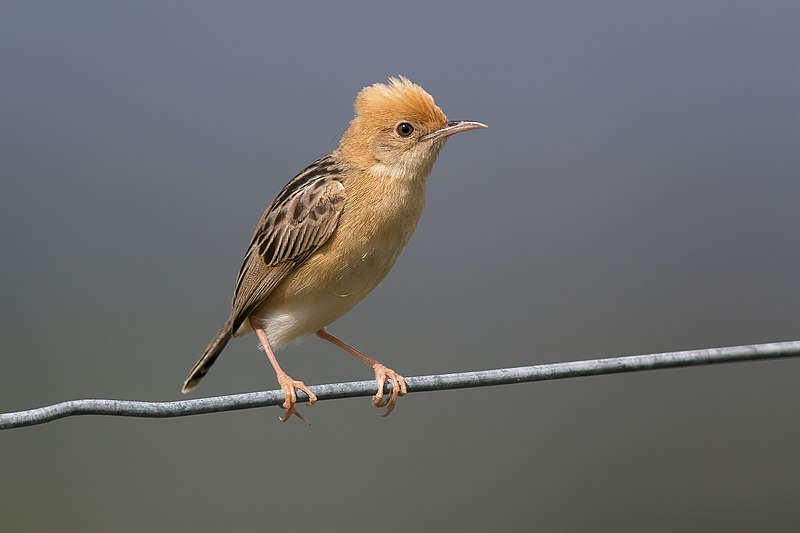
The Golden-headed cisticola, also known as the bright-capped cisticola, is a petite species of warbler found in thirteen countries across Asia and Australia.
Typically, the bird measures between 9 to 11.5 cm (3.5-4.5 in) and sports a brown and cream coat.
However, during the breeding season, the male of the species takes on an appearance more fitting of its name, displaying a stunning golden body and much shorter tail than usual.
An omnivore, the Golden-headed cisticola feeds on both plants and animals.
Scientific classification:
| Kingdom | Animalia |
| Phylum | Chordata |
| Class | Aves |
| Order | Passeriformes |
| Family | Cisticolidae |
| Genus | Cisticola |
| Species | C. exilis |
49. Scarlet Myzomela
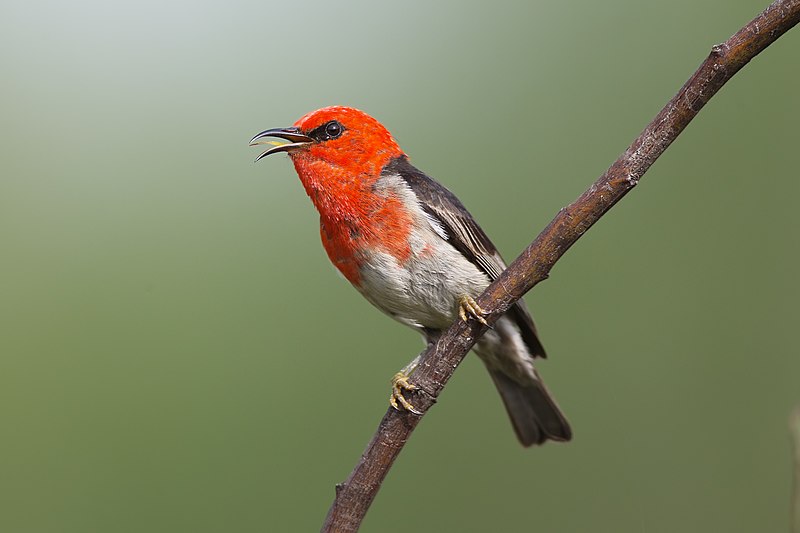
The Scarlet myzomela, also known as the Scarlet honeyeater, is a tiny bird from Australia belonging to the honeyeater family. It was identified by John Latham, an ornithologist from England in 1801.
With a length of only 9 to 11 centimeters, it is the smallest honeyeater bird in Australia featuring a short tail and a long, down-curved beak.
The male and female Scarlet myzomelas have a noticeable difference with respect to their gender.
The male Scarlet myzomela has a vibrant scarlet coloration while female birds have olive-green feathers. Scarlet myzomela birds often feed on the nectar of flowers while hovering in the air.
These birds are seen to feed on plants such as eucalyptus, grevillea, and paperbark among others.
Scarlet myzomelas are little creatures that add vibrancy to the colorful wildlife of Australia.
Scientific classification:
| Kingdom | Animalia |
| Phylum | Chordata |
| Class | Aves |
| Order | Passeriformes |
| Family | Meliphagidae |
| Genus | Myzomela |
| Species | M. sanguinolenta |